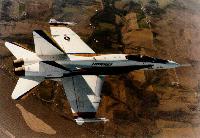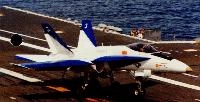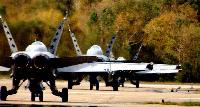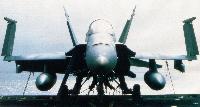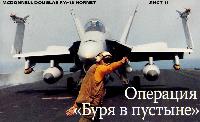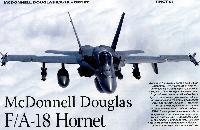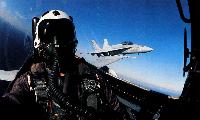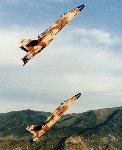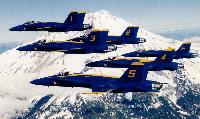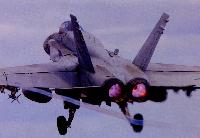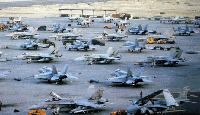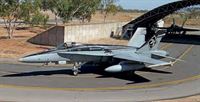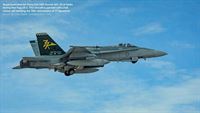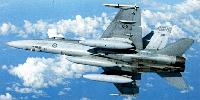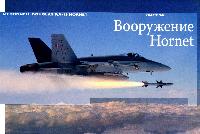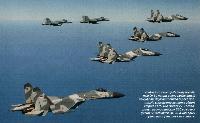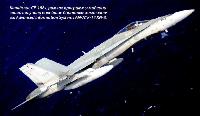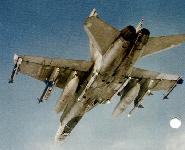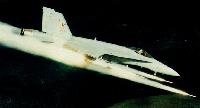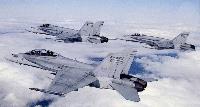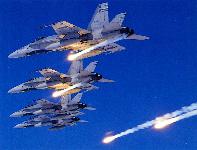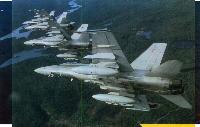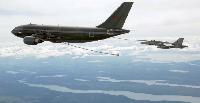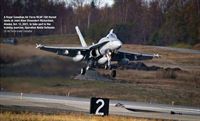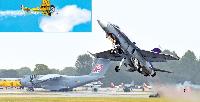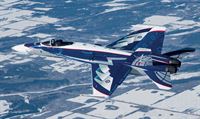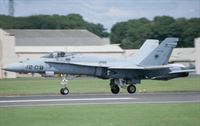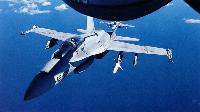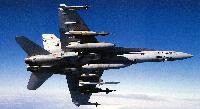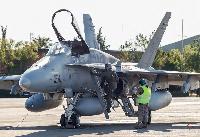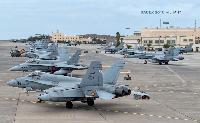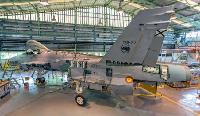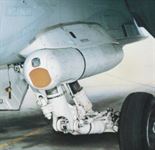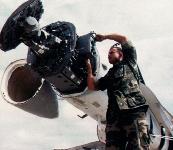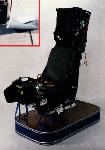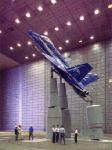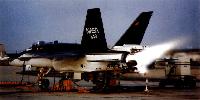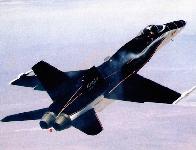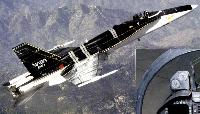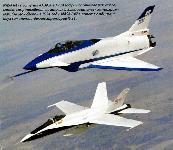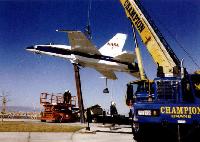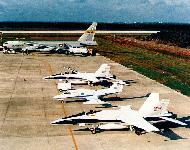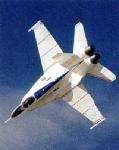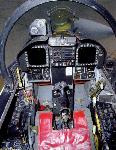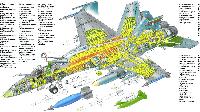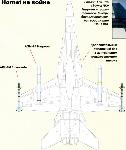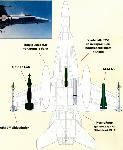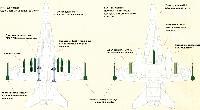
Варианты
- Northrop - YF-17 Cobra - 1974 - США
- McDonnell Douglas - F/A-18A Hornet - 1978 - США
- McDonnell Douglas - F/A-18B Hornet - 1979 - США
- McDonnell Douglas - F/A-18C Hornet - 1986 - США
- McDonnell Douglas - F/A-18D Hornet - 1987 - США
- McDonnell Douglas - F/A-18E Super Hornet - 1995 - США
- McDonnell Douglas - F/A-18F Super Hornet - 1995 - США
- Boeing - EA-18G Growler - 2006 - США
Фотографии
-
Мировая Авиация 129
F/A-18A, "Blue Angels". Пилотажная группа ВМС США "Blue Angels" в 1986 году сменила A-4 Skyhawk на F/A-18A/B. Изображен самолет ранней постройки, IV производственной серии. Вместо пушки установлен бак и дымогенератор.
-
Мировая Авиация 129
F/A-18A Hornet, 131-я ишаэ "Wildcats". "Wildcats" - одна из двух первых эскадрилий Атлантического флота, получивших Hornet. Первый поход на авианосце "Коралл Си" в Средиземное море она выполнила в октябре 1985 - мае 1986 годов. 13-е корабельное авиакрыло принимало участие в операции "Каньон Эльдорадо", направленной против Ливии. Именно тогда Hornet принял боевое крещение - с F/A-18A были применены противорадиолокационные ракеты HARM, изображенные на рисунке.
-
Air International 1995-09 / R.Francillon - Aggressive surrogates /Flying colours/
McDonnell Douglas F/A-18A 162472, of VFC-12, NAS Oceana, October 1994, in two tone blue wrap around camouflage and low-visibility markings. The black and light grey wedges on the fin tips are to simulate the Sukhoi Su-27 Flanker fin tip shape.
-
Мировая Авиация 129
F/A-18A, КМП США. КМП США принял на вооружение Hornet в качестве истребителя-бомбардировщика аэродромного базирования. Именно КМП первым получил F/A-18 на вооружение. 312-я истребительно-штурмовая эскадрилья "Checkerboards" сменила F-4S Phantom на F/A-18A в 1988 году - эскадрилья тогда входила в 31-ю авиационную группу авиации КМП.
-
Мировая Авиация 129
F/A-18A, НАСА. НАСА использовало Hornet для выполнения широкого круга задач, в том числе исследования полетов на больших углах атаки, для имитации БЛА, поддерживания натренированности летного состава и как самолет сопровождения. Изображенный самолет с марта 1987 года был задействован в исследованиях полетов с большими углами атаки и маневрирования на малых скоростях.
-
Мировая Авиация 129
EF-18A, ВВС Испании. Испания закупила 72 самолета EF-18A/B, а в 1990-е годы - еще 24 самолета, ранее состоявших на вооружении ВМС США. Изображен самолет из Ala 15, дислоцированной в Сарагосе, где базируются три эскадрильи Hornet.
-
Мировая Авиация 129
CF-18A, ВС Канады. Канада стала первым после США государством, принявшим на вооружение Hornet. В Канаде самолеты получили обозначение CF-188 или CF-18A/B. Изначально канадские Hornet базировались в Канаде и ФРГ, но из ФРГ они были выведены в Канаду в 1992 году. 421-я эскадрилья "Red Indian" вместе с двумя другими канадскими эскадрильями Hornet базировалась в Баден-Золлингене.
-
Мировая Авиация 129
F/A-18A, Королевские ВВС Австралии. Австралия закупила 75 Hornet, вооружив ими три строевые эскадрильи и тренировочное подразделение. Изображен самолет 77-й эскадрильи, ранее на ее вооружении состояли P-51 и Meteor. Последние использовались в Корее, где на них появились эмблемы в виде "льва мира" (Peace Lion), в просторечии известного как "сварливая обезяьна" (Grumpy Monkey).
-
Air International 1978-12 / ??? - From Cobra to Hornet... The venomous F-18
Another view of the F-18A Hornet as rolled out at St Louis in September 1978.
-
Мировая Авиация 113
Первый полет первого опытного самолета YF-18 состоялся 18 ноября 1978 года. В программе летных испытаний были задействованы девять одноместных и два двухместных самолета.
-
Мировая Авиация 70
18 ноября 1978г.: первый полет выполнил прототип палубного истребителя-бомбардировщика McDonnell Douglas F/A-18 Hornet (160775).
-
Авиация и Время 2014-02 / И.Михелевич - Универсальный солдат. Самолет F/A-18 Hornet
Первый прототип YF-18 в полете, апрель 1979 г.
-
Мировая Авиация 113
Hornet был создан на базе истребителя Northrop YF-17. По сравнению с последним он имел увеличенное крыло, новую носовую часть с РЛС, усовершенствованную силовую установку и оборудование для палубной эксплуатации.
-
Мировая Авиация 23
Пятый прототип Hornet был задействован в испытаниях подвесного вооружения. На фотографии - пуск ракеты AIM-7 Sparrow. В ходе испытаний этот самолет сбил 12 летающих мишеней, отметки о "победах" нанесли на фюзеляж под кабиной.
-
Jane's All the World Aircraft 1980 / Encyclopedia of Aviation - Aircraft A-Z - v4
Prototype McDonnell Douglas F-18 Hornet.
-
Мировая Авиация 113
При создании планер самолета рассчитывался на ресурс не менее 2000 посадок с использованием тормозного крюка (гака) и на столько же взлетов с использованием катапульты.
-
Мировая Авиация 140
15 августа 1984г.: начались летные испытания оснащенного разведывательным оборудованием истребителя F/A-18(R) (позднее RF-18) Hornet.
-
Air International 1983-10 / F.Mormillo - Debut for the Hornet
A line up of VFA-125 F/A-18As, with one two-seat TF-18A. The "F/A-18" designation is favoured by the US Navy to publicise the Hornet's dual fighter/attack role, although the aircraft carry only "F-18A" as their official designation.
Другие самолёты на фотографии: McDonnell Douglas F/A-18B Hornet - США - 1979
-
Мировая Авиация 8
Обе эскадрильи авиации корпуса морской пехоты США на "Coral Sea" в 1983 году находились в состоянии полной боеготовности. Эскадрильи дислоцировались в Эль-Торо, Калифорния, их временно передали в 13-е палубное авиакрыло из-за нехватки самолетов F/A-18 в авиации Атлантического флота.
-
Авиация и Космонавтика 2011-12 / М.Никольский - "Супер Хорнет" (2)
F/A-18C и F/A-18E
Другие самолёты на фотографии: McDonnell Douglas F/A-18E Super Hornet - США - 1995
-
Air International 2011-07 / News
CVW-8 has four Strike Fighter Squadrons, operating F/A-18A+ and F/A-18C Hornets, and F/A-18E/F Super Hornets.
Другие самолёты на фотографии: McDonnell Douglas F/A-18E Super Hornet - США - 1995
-
Мировая Авиация 97
"Энтерпрайз" полгода спустя после начала операции "Несокрушимая свобода". Палубная техническая команда стоит перед F/A-18 Hornet, три Tomcat ожидают своей очереди постановки на катапульту.
Другие самолёты на фотографии: Grumman F-14 Tomcat - США - 1970
-
Air International 2017-07 / L.Nordeen - Sustaining Marine Corps Hornets /Military/
A member of the airframes shop, assigned to Marine Fighter Attack Squadron 115 (VMFA-115) ‘Silver Eagles’ performs maintenance on the tail hook of an F/A-18A+ Hornet on the flight deck of USS Harry S. Truman (CVN 75).
-
Мировая Авиация 138
F/A-18+ в ВМС США дислоцируются лишь в Новом Орлеане - в составе 204-й ишаэ авиации Резерва ВМС.
-
Мировая Авиация 161
AIM-9X рассчитана на эксплуатацию самолетами палубной авиации в сложных условиях базирования на авианосцах. На торцевой пилон F/A-18 ВМС США подвешена УР AIM-9X.
-
Мировая Авиация 23
Самолеты F/A-18 своим необычным видом не только изменили привычную картину палуб авианосцев, но и способствовали изменению принципов боевого применения палубных авиакрыльев. Комплексная бортовая авионика позволяла использовать эти самолеты как для ведения воздушных боев, так и для поражения наземных или надводных целей.
-
Мировая Авиация 23
Хотя совместимость самолета Hornet с авианосцем поначалу вызывала сомнения, он быстро зарекомендовал себя отличным палубным самолетом.
-
Мировая Авиация 104
Из всей авиации ВМФ США только экипажи Hornet смогли одержать воздушные победы в небе Ирака, что сильно огорчало экипажи F-14 Tomcat. На фотографии готовится к старту истребитель F/A-18A с ракетами AIM-9 Sidewinder. Оба сбитых иракских самолета были поражены этими ракетами.
-
Мировая Авиация 104
Этот Hornet КМП США снят перед вылетом. Американские F/A-18 были не единственными такими машинами на иракской войне. Канада тоже прислала 18 самолетов CF-18.
-
Мировая Авиация 8
Палубная команда подготовила к взлету с катапульты истребитель-бомбардировщик Hornet из эскадрильи VFA-131 "Wildcat", авианосец "Coral Sea". Эскадрилья VFA-131 "Wildcat" была сформирована в 1983 году, ее первый поход на борту авианосца начался в октябре 1985 года в Средиземное море.
-
Мировая Авиация 96
314-я истребительно-штурмовая эскадрилья "Black Knights" КМП США стала первым оснащенным Hornet подразделением, получившим боевое крещение. Это произошло в 1986 году - самолеты базировавшейся на авианосце "Корал Си" эскадрильи участвовали в конфликте с Ливией. Самолет на фотографии несет восемь 227-килограммовых авиабомб.
-
Мировая Авиация 23
В авиации Корпуса морской пехоты США самолеты Hornet интенсивно используются в качестве ударных, хотя данный F/A-18C (фотография сделана в период проведения операции "Освобождение Ирака") неплохо вооружен и для ведения воздушного боя. На торцевых пилонах крыла подвешены УР AIM-9 Sidewinder, на правом подфюзеляжном пилоне установлена ракета среднего радиуса AIM-120, а вооружение класса "воздух-поверхность" представлено корректируемой бомбой GBU-12 (под правой консолью крыла) и боеприпасом JDAM (под левой). На внутреннем правом подкрыльевом пилоне укреплен топливный бак.
-
Мировая Авиация 28
Hornet из эскадрильи VNFA-323 с восемью бомбами Mk 82 и двумя УР "воздух-воздух" AIM-9. В ходе операции "Буря в пустыне" F/A-18 выполнили больше боевых вылетов, чем любой другой самолет авиации ВМС и Корпуса морской пехоты США. Самолеты Hornet прошли боевое крещение в период конфронтации США с Ливией в 1986 году, когда они, взлетая с авианосцев, наносили удары по объектам на ливийском побережье. В 1990-е годы истребители-бомбардировщики Hornet, включая F/A-18D, участвовали в боевых действиях на Балканах.
-
Air International 2022-08 / T.Fish - Protect Yourself
The ALE-47 countermeasures dispenser system is able to interface with a wide variety of radar, laser and missile warning receivers and jammers. This reduces the cost of installation. It has a cockpit control unit, sequencer units, dispensers and a programmer
-
Air International 1983-06 / R.Braybrook - Lee Begin of Northrop /Aircraft Design Philosophy/ (1)
F/A-18 начал свою карьеру в эскадрилье VFA-125. На фотографии: самолет этой эскадрильи, получившей первый Hornet 13 ноября 1980 года.
The F-18A Hornet is the latest aircraft to enter service with the design of which Begin has been associated. The design, originated by Northrop as the YF-17, was navalised by McDonnell Douglas. -
Мировая Авиация 110
F/A-18A с двумя ПКР Harpoon на испытаниях в Центре боевого применения вооружения ВМС США.
-
Мировая Авиация 96
Парк самолетов F/A-18 авиации КМП США после окончания холодной войны был существенно сокращен - эта участь постигла и вооруженную F/A-18A 451-ю истребительно-штурмовую эскадрилью "Warlords", расформированную в 1998 году.
-
Мировая Авиация 113
"Главным калибром" флота в афганской войне стали F/A-18 "Хорнет"
Эскадрилья VFA-113 "Stingers" стала первым подразделением ВМС США, получившим F/A-18. На снимке 1984 года хорошо видны опознавательные знаки пониженной заметности и серый камуфляж строевой машины. Этот самолет, взлетевший с авианосца "Констеллейшн", сбрасывает пару 227-кг бомб Mk 82 во время учебного вылета. -
Air International 1983-10 / F.Mormillo - Debut for the Hornet
The Hornet has been well received by pilots of the operational squadrons now converting onto the type, despite the doubts cast upon its future by continued political sniping engendered by its escalating cost and some early performance deficiencies. VMFA-314 flew their Hornets for these photographs to be taken by Frank B Mormillo from the cargo ramp of a KC-130 Hercules.
-
Мировая Авиация 23
Отличный обзор из кабины и превосходная маневренность делает F/A-18 великолепным истребителем завоевания превосходства в воздухе. Он стал первым в мире серийным истребителем, приборное оборудование которого выполнено по принципу "стеклянной кабины".
-
АвиаМастер 2000-01 / М.Никольский - "Агрессоры" готовятся к войне /На том берегу/
F/A-18 "Хорнет", раскрашенный "под Су-27". Обратите внимание на попытки визуального изменения геометрии планера.
-
Мировая Авиация 96
F/A-18A/B до сих пор эксплуатируются ВМС США в роли "агрессоров", хотя одна из таких эскадрилий, VFC-12 "Omars", пересела с F/A-18A+ на F/A-18C еще в 2006 году.
-
Air International 2007-10 / T.Carlson - Aggressor Tigers /Military/
A pair of VFC-13 F-5Ns formate on a VFC-12 F/A-18 Hornet. Mixed formations of aggressor aircraft are commonplace and pose an increased challenge to their opponents.
Другие самолёты на фотографии: Northrop F-5E Tiger II - США - 1972
-
Air International 2016-08 / Airscene
F/A-18A+ Hornet BuNo 162863/AF11 of Fighter Composite Squadron 12 (VFC-12) ‘Fighting Omars’ based at Naval Air Station Oceana, Virginia seen at Fallon, Nevada in late-May 2016. VFC-12 deployed to Fallon to bolster the resident adversary force during Carrier Air Wing 8’s latest work-up.
-
Air International 2015-09 / News
Fighter Squadron Composite 12 (VFC-12) ‘Fighting Omars' based at Naval Air Station Oceana, Virginia operates the F/A-18A Hornet. The squadron provides adversary support to strike fighter squadrons and deployed some of its jets to Naval Air Station Fallon, Nevada in support of Carrier Air Wing 7’s recent detachment to the desert base.
-
Air International 2018-01 / News by countries
Strike Fighter Squadron 204 (VFA-204) 'River Rattlers' based at Naval Air Station New Orleans became the first Reserve strike fighter squadron to provide adversary support to the active-duty fleet in October 1993. The squadron currently operates F/A-18A Hornet BuNo 162859/AF414, shown carrying a blue-coloured ALQ-167(V) electronic countermeasures jamming pod, painted in a three-tone ghost colour scheme.
-
Мировая Авиация 23
В Соединенных Штатах самолет F/A-18 хорошо известен по показательным выступлениям пилотажной группы авиации ВМС США "Blue Angels". На фотографии: летчики из этой группы демонстрируют проход в плотном строю.
To start its 2008 season, the Navy Flight Demonstration Squadron, better known as the Blue Angels, performed at the El Centro, California, air show in March. The Blue Angels claims the distinction of being the oldest continuous aerobatic team in the world. -
Air International 1999-11 / R.Burgess - United States Navy Today /Military aviation/ (2)
Formation flypast by four F/A-18s of the Blue Angel demonstration team. Formally known as the Naval Flight Demonstration Squadron, it is part of the Naval Air Training Command.
-
Мировая Авиация 96
Пилотажная группа ВМС США "Blue Angels" летала на F/A-18A/B с 1986 года, но в 2009 году приступила к переоснащению на модификацию C/D. Однако двухместный F/A-18B по-прежнему используется для тренировок.
-
Air International 2006-09 / R.Burgess - US Naval aviation 2006 /Military/ (3)
Boeing F/A-18A and B versions of the Hornet are used by the Naval Flight Demonstration Squadron - the Blue Angels - to demonstrate the skill of US naval aviators at airshows across North America and, occasionally, in other countries.
-
Air International 2020-07 / K.Chapman - World War COVID-19
Saluting Angels. As part of ‘America Strong’ tributes, the USAF Thunderbirds and US Navy Blue Angels teamed up for a flyover of New York City on April 28, 2020, saluting health care and other key workers leading the fight against the coronavirus.
Другие самолёты на фотографии: General Dynamics F-16A/C/E Fighting Falcon - США - 1974General Dynamics F-16B/D Fighting Falcon - США - 1977
-
Авиация и Космонавтика 2016-01 / М.Никольский - Пилотажная группа "Блю Энжелз"
В полете "хорнеты" пилотажной группы "Блю Энжелз"
-
Air International 1987-10 / Talkback
Photographs provided by Douglas E Slowiak show the McDonnell Douglas Hornets that now equip the US Navy aerobatic team, the "Blue Angels".
-
Авиация и Космонавтика 2016-01 / М.Никольский - Пилотажная группа "Блю Энжелз"
Другие самолёты на фотографии: Lockheed C-130 Hercules - США - 1954
-
Авиация и Время 2014-02 / И.Михелевич - Универсальный солдат. Самолет F/A-18 Hornet
F/A-18A из пилотажной эскадрильи ВМС США «Голубые ангелы». Гавайи, Канеох Бэй, 27 сентября 2012 г.
-
Air International 1983-10 / F.Mormillo - Debut for the Hornet
Marine Corps squadron VMGR-352 provides a KC-130H for air-to-air refuelling of an F/A-18A, using the British-developed probe-and-drogue system.
-
Air International 2013-10 / Tankers (1)
An F/A-18A Hornet assigned to No.3 Squadron Royal Australian Air Force refuels from KC-30A A39-005 over the Pacific Ocean near the island of Guam during this year's exercise Cope North.
Другие самолёты на фотографии: Airbus A330 MRTT / KC-30 Voyager - International - 2007
-
Мировая Авиация 28
ШАССИ. F/A-18 на глиссаде, перед касанием палубы авианосца. Отклонена вся взлетно-посадочная механизация крыла, выпущены шасси и тормозной гак. Самолет обладает очень прочным шасси, способным выдержать сильный удар о палубу при выполнении посадки без выравнивания и значительную нагрузку, которая возникает при зацеплении гаком троса аэрофинишера. На ранних этапах программы самолета Hornet фирма "Northrop" проектировала вариант сухопутного базирования F-18L с облегченным шасси и рядом других конструктивных изменений, но удача сопутствовала фирме "McDonnell Douglas", предложившей иностранным заказчикам свою сухопутную версию F/A-18. Ни одного F-18L построено не было.
-
Air International 2018-01 / D.Isby - US combat air power today and beyond /Military/
An F/A-18C Hornet assigned to Marine Fighter Attack Squadron 115 (VMFA-115) 'Silver Eagles' conducts an arrested landing during an Integrated Training Exercise at Marine Corps Air Ground Combat Center, Twentynine Palms, California.
-
Мировая Авиация 8
Hornet из эскадрильи VMFA-323 выполнил посадку на палубу авианосца "Coral Sea". Самолеты эскадрильи "Death Rattlers" штатно несли на килях аббревиатуру "WS", но в период базирования на авианосце "Coral Sea" буквы "WS" на самолетах эскадрильи заменили буквами "АК" - 13-е палубное авиакрыло.
-
Мировая Авиация 58
Самолеты A-6E Intruder и F/A-18A/C Hornet авиации КМП США занимались поддержкой сухопутных сил, осуществляя воздушное прикрытие, подавление средств ПВО и нанося штурмовые удары.
Другие самолёты на фотографии: Grumman A-6 Intruder - США - 1960
-
Мировая Авиация 8
Подготовка к полету самолета F/A-18 Hornet, авианосец "Coral Sea". Самолет и его сложные и высокотехнологичные системы на деле продемонстрировали свою надежность и безотказность.
-
Air International 2011-10 / A.Boxman, K.van der Mark - Alaskan Wars /Military/
A pilot from No.3 Squadron RAAF climbs aboard an F/A-18A Hornet for a familiarisation flight from Eielson AFB.
-
Air International 2002-08 / Airscene
Republic of Singapore Air Force (RSAF) F-5S 822, with an RAAF Hornet behind, was one of 60 RAAF and RSAF aircraft taking part in Exercise Pitch Black 2002, Australia’s largest air defence exercise, held roughly every two years. The air combat phase of the exercise was held this year between July 15 - August 2.
Другие самолёты на фотографии: Northrop F-5E Tiger II - США - 1972
-
Air International 2016-12 / Airscene
The Royal Australian Air Force F/A-18A Hornets were also based alongside the RAF detachment in RMAF Butterworth, Penang.
Другие самолёты на фотографии: Eurofighter Typhoon / EF-2000 - International - 1994
-
Air International 2011-09 / N.Pittaway - Rattling the Sabre /Military/
Регистрационный номер: A21-43 [2] RAAF Tindal is home to No.75 Squadron equipped with upgraded F/A-18A Hornets which played a significant part in Talisman Sabre 11.
-
Air International 2018-10 / N.Pittaway - Outback Air Combat Exercise Pitch Black /Military/
Регистрационный номер: A21-38 [5] F/A-18A Hornet A21-38 painted in colour markings commemorating the 75th anniversary of Royal Australian Air Force 75 Squadron, seen at Tindal.
-
Air International 2019-06 / N.Pittaway - Twilight for Australia's Hornets /Military/
Регистрационный номер: A21-38 [5] F/A-18A Hornet A21-38 is painted in a black and silver paint scheme to commemorate the 75th anniversary of the Royal Australian Air Force's 75 Squadron based at Tindal in the Northern Territory.
-
Air International 2019-12 / M.Ayton - Red Flag's big shift /Military/
Регистрационный номер: A21-35 Royal Australian Air Force F/A-18A Hornet A21-35 at Nellis during Red Flag 19-1. This aircraft is painted with a full colour tail marking the 75th anniversary of T1 Squadron.
-
Мировая Авиация 100
Регистрационный номер: A21-21 Сегодня австралийские Hornet уже могут применять ракеты MBDA ASRAAM, обладающие лучшими характеристиками по сравнению с ракетами Sidewinder. В ходе испытаний австралийские F/A-18 успешно продемонстрировали возможность пуска данной УР по целям в задней полусфере, что получило на Западе название "парфянский выстрел".
-
Мировая Авиация 114
Регистрационный номер: A21-13 -
Air International 2017-01 / L.Nordeen - Still Got Sting /Military/
Регистрационный номер: A21-40 Australia is one of seven international F/A-18 Hornet customers. The type continues to equip three front line Royal Australian Air Force squadrons and one operational conversion unit.
-
Мировая Авиация 96
Регистрационный номер: A21-26 [2] Все австралийские эскадрильи, получившие Hornet, летали до того на Mirage III. 77-я эскадрилья была переформирована 1 июля 1987 года и получила свои первые самолеты через некоторое время, а главной задачей ее летчиков является разработка новых приемов и способов ведения воздушного боя.
-
Air International 2019-06 / N.Pittaway - Twilight for Australia's Hornets /Military/
Регистрационный номер: A21-54 F/A-18A Hornet A21-54 assigned to 77 Squadron with the unit's latest tail markings.
-
Air International 2024-09 / J.Lake - MBDA's market-leading, world-beating AAMs
An MBDA ASRAAM can be seen on the wingtip of the RAAF Hornet in the foreground while his wingman carries twin AMRAAMs underwing. ASRAAM has not been integrated on the newer Super Hornet for largely budgetary reasons
-
Air International 2011-10 / A.Boxman, K.van der Mark - Alaskan Wars /Military/
Регистрационный номер: A21-49 [4] F/A-18A Hornet A21-49 of No.3 Squadron RAAF flies low over the Alaskan tundra during Exercise Red Flag Alaska 11-2.
-
Авиация и Время 2014-02 / И.Михелевич - Универсальный солдат. Самолет F/A-18 Hornet
Регистрационный номер: A21-3 [2] F/A-18A из 3-й АЭ Королевских ВВС Австралии, сентябрь 2013 г.
-
Мировая Авиация 164
Регистрационный номер: A21-43 [2] -
Air International 2019-09 / N.Pittaway - Testing times 75 years of ARDU /Military/
Регистрационный номер: A21-32 [2] F/A-18A Hornet A21-32 assigned to the Aircraft Research and Development Unit, transits over the Woomera Test Range after a test mission for the JDAM-ER.
-
Air International 2016-10 / Airscene
Регистрационный номер: A21-49 [4] F/A-18A Hornets from the RAAF’s No. 77 Squadron, including A21-49 painted in a full-colour paint scheme to mark the squadron’s 70th anniversary, flew offensive counter air, strike, dynamic targeting and close escort missions during Pitch Black 2016.
-
Мировая Авиация 126
Регистрационный номер: A21-25 В 1998 году австралийские ВВС для своих Hornet выбрали ракеты AIM-132 ASRAAM для замены AIM-9 в качестве оружия ближнего воздушного боя. Европейская ракета обошла и израильскую ракету Python 4, и американскую AIM-9X Sidewinder. Но на австралийских Super Hornet вместо ASRAAM планируют использовать AIM-9X.
-
Air International 2019-09 / N.Pittaway - Testing times 75 years of ARDU /Military/
Регистрационный номер: A21-32 [2] -
Мировая Авиация 114
Регистрационный номер: A21-12, A21-18 [2] -
Air International 2015-11 / News
F/A-18A Hornets from Australia’s Air Task Group fly in formation with a Royal Australian Air Force KC-30A Multi-Role Tanker Transport aircraft during the first mission of Operation Okra to be flown over Syria.
-
Air International 2013-04 / News
Регистрационный номер: A21-29, A21-48 McDonnell Douglas F/A-18A Hornet A21-29 of No.77 Squadron, Royal Australian Air Force, is the unit commanders' aircraft and was painted to celebrate its 70th anniversary in 2012. The fighter is seen on its way to the Australian Airshow and Aerospace & Defence Exposition at Avalon Airport, Victoria, on February 27, 2013, with A21-48, which features tail markings for the air force's 90th anniversary in 2011.
-
Air International 2019-06 / N.Pittaway - Twilight for Australia's Hornets /Military/
Регистрационный номер: A21-50 F/A-18A Hornets assigned to 77 Squadron based at Williamtown in New South Wales with the unit's original tail markings.
-
Air International 2015-06 / News
Регистрационный номер: A21-16 A pair of F/A-18A Hornets bank away from the KC-30A Multi Role Tanker Transport over Iraq.
-
Air International 2015-08 / N.Pittaway - Introducing Growler /Military/
Регистрационный номер: A21-53 Другие самолёты на фотографии: Boeing EA-18G Growler - США - 2006
-
Мировая Авиация 126
Регистрационный номер: A21-3 [2] Австралийские Hornet продолжают использовать устаревшие ракеты AIM-7 Sparrow. Учения, в ходе которых австралийским F/A-18 противостояли малазийские МиГ-29 с ракетами Р-77, вызвали шок у военных, ярко продемонстрировав все недостатки AIM-7. Сегодня самолеты австралийских ВВС вооружены и AIM-7, и AIM-120 AMRAAM.
-
Air International 2017-06 / N.Pittaway - Waltzing Matilda /Military/
Australia’s first F-35A Lightning IIs, A35-001 and A35-002, fly in formation with No.2 Operational Conversion Unit F/A-18A Hornet displaying its 75th anniversary livery on transit to the Australian International air show in Avalon.
Другие самолёты на фотографии: Lockheed F-35A Lightning II - США - 2006
-
Air International 2019-02 / Airscene
Right echelon formation with F-35A A35-010 closest to the camera.
Другие самолёты на фотографии: Lockheed F-35A Lightning II - США - 2006McDonnell Douglas F/A-18B Hornet - США - 1979
-
Air International 2019-02 / Airscene
Регистрационный номер: A21-38 [5] Другие самолёты на фотографии: Lockheed F-35A Lightning II - США - 2006McDonnell Douglas F/A-18B Hornet - США - 1979
-
Air International 2019-02 / Airscene
Регистрационный номер: A21-38 [5] Three F/A-18 Hornets lead the first two Royal Australian Air Force F-35A Lightning IIs, seen in this shot performing a stylish formation break.
Другие самолёты на фотографии: Lockheed F-35A Lightning II - США - 2006McDonnell Douglas F/A-18B Hornet - США - 1979
-
Air International 2011-09 / News
Регистрационный номер: A21-49 [4] F/A-18A Hornet A21-49 of No. 3 Squadron, RAAF, and F-15J Eagle 22-8933 of 303 Hikotai, 6 Kokudan, JASDF, flying over the Japanese countryside on July 14, 2011 during the first training sortie by the RAAF in the country.
Другие самолёты на фотографии: McDonnell Douglas F-15A/C Eagle - США - 1972
-
Air International 2018-10 / News by countries
A Rafale B with two Royal Australian Air Force F/A-18s during Pitch Black 2018.
Другие самолёты на фотографии: Dassault Rafale B / D / F - Франция - 1993
-
Air International 2014-10 / News
Some of the fast jet participants in Pitch Black 2014: two Royal Australian Air Force F/A-18 Hornets, a Royal Thai Air Force JAS39D Gripen, USAF F-16C, a UAE Air Force Mirage 2000 and a Royal Singapore Air Force F-15SG.
Другие самолёты на фотографии: Dassault Mirage 2000 - Франция - 1978General Dynamics F-16A/C/E Fighting Falcon - США - 1974McDonnell Douglas F/A-18F Super Hornet - США - 1995McDonnell Douglas F-15E Strike Eagle - США - 1986SAAB Gripen / JAS-39B/D - Швеция - 1996
-
Авиация и Космонавтика 2020-11 / С.Мороз - Противник номер один (19)
Целью модернизации комплекса связи B-52H в XXI веке является его глобальное применение в разнородных авиационных группировках
Exercise Cope North Guam 2014 was held between February 14 and 28, 2014. It was a multilateral training exercise conducted from Andersen AFB, Guam, and involved around 80 aircraft from the Japan Air Self Defense Force (JASDF), Royal Australian Air Force (RAAF) and US Air Force and Navy. Air-to-air training was conducted involving dissimilar air combat scenarios, air-to-ground sorties and simulated humanitarian assistance and disaster relief operations. This formation of participants comprises an EA-18G Growler of VAG-132 (tailcode ‘NL’), F-16C Fighting Falcon from the 35th Fighter Wing (‘WW), an 18th Wing F-15D Eagle (ZZ), a B-52H Stratofortress from the 20th Bomb Squadron ('LA'), JASDF F-15J (22-0929 of 204 Hikotai) and Mitsubishi F-2A, an RAAF No. 75 Squadron F/A-18A Hornet and an F-16C of the 364th Fighter Wing (‘AK').Другие самолёты на фотографии: Boeing B-52H Stratofortress - США - 1960Boeing EA-18G Growler - США - 2006General Dynamics F-16A/C/E Fighting Falcon - США - 1974McDonnell Douglas F-15A/C Eagle - США - 1972McDonnell Douglas F-15B/D Eagle - США - 1972Mitsubishi FS-X / F-2 - Япония - 1995
-
Air International 2014-10 / News
RAAF KC-30As have recently supported the Pitch Black, Stone Age and Arnhem Thunder exercises.
Другие самолёты на фотографии: Airbus A330 MRTT / KC-30 Voyager - International - 2007
-
Air International 2011-10 / A.Boxman, K.van der Mark - Alaskan Wars /Military/
Регистрационный номер: A21-49 [4], A21-56 F/A-18 Hornets from No.3 Squadron RAAF join in formation with Japan Air Self Defense Force F-15s and a Boeing KC-767J tanker during Exercise Red Flag Alaska 11-2.
Другие самолёты на фотографии: Boeing KC-767 / KC-46 Pegasus - США - 2005McDonnell Douglas F-15A/C Eagle - США - 1972
-
Air International 2017-04 / P.Butowski - Flanker /Military/
В дополнение к своим девяти ударным истребителям Су-30МК/МК2 Индонезия с 2003 года получила еще пару Су-27СК и три Су-27СКМ. На снимке: четыре Су-27СК/СКМ в одном строю с парой австралийских F/A-18A Hornet во время совместных учений в 2012 году.
Su-27SKM TS-2705 is one of three such aircraft unique to the Tentara Nasional Indonesia-Angkatan Udara; all were delivered in 2010.Другие самолёты на фотографии: Сухой Су-27 - Россия - 1981Сухой Су-30 - Россия - 1988
-
Мировая Авиация 230
Индонезийские Су-27 и двухместные Су-30 несут очень эффектный камуфляж двух оттенков серого цвета. На снимке они летят в одном строю с F/A-18A Hornet 77-й эскадрильи австралийских ВВС во время учений "Pitch Black 2012", в которых принимали участие семь стран.
Другие самолёты на фотографии: Сухой Су-27 - Россия - 1981Сухой Су-30 - Россия - 1988
-
Air International 2012-09 / ??? - Thunder over the Outback /Military/
Регистрационный номер: A21-20, A21-51 No.77 Squadron F/A-18 Hornets welcome Indonesian Air Force Sukhoi Su-27 and Su-30 Flanker aircraft into Darwin to participate in Exercise Pitch Black 2012.
Другие самолёты на фотографии: Сухой Су-30 - Россия - 1988
-
Авиация и Время 2012-04
C 30 июля по 17 августа 2012г. в воздушном пространстве Австралии и Индонезии прошли многонациональные авиационные маневры Pitch Black 2012. В них приняли участие 2200 человек и 94 самолета из Австралии, Индонезии, Сингапура, Таиланда, Новой Зеландии и США, в том числе 4 истребителя Су-27 и Су-30МК2 ВВС Индонезии
Другие самолёты на фотографии: Сухой Су-27 - Россия - 1981Сухой Су-30 - Россия - 1988
-
Air International 2011-08 / News
Регистрационный номер: A21-47 No.3 Squadron of the Royal Australian Air Force based at RAAF Base Williamtown, New South Wales, deployed seven McDonnell Douglas F/A-18A/B Hornets to Eielson AFB, Alaska, to participate in a Red Flag exercise. Red Flag Alaska 11-2 ran from July 11 until July 22, 2011 and involved packages of more than 100 aircraft flying over the Joint Alaska Pacific Range Complex. The Hornets took part in counter air, precision strike and offensive air operations, and are seen here tanking from McDonnell Douglas DC-10-401 N974W (c/n 46974) of Omega Air. During the exercise the fighters were supported by a single Lockheed Martin C-130J Hercules from No.37 Squadron, which was based at Elmendorf AFB, Alaska.
Другие самолёты на фотографии: McDonnell Douglas KC-10 Extender - США - 1981
-
Air International 2012-01 / M.Ayton - Six ... back on the road /Military/
No.101 Squadron deployed VC10 C1K XV108/'Y' to Subang AB for the three-week exercise. The tanker was used by the Typhoons but also by RAAF F/A-18 Hornets.
Другие самолёты на фотографии: Eurofighter Typhoon / EF-2000 - International - 1994Vickers VC-10 - Великобритания - 1962
-
Air International 2011-12 / News
Регистрационный номер: A21-38 [5] F/A-18A Hornet A21-38 takes off From the Royal Malaysian Air Force base at Butterworth during Exercise Bersama Lima 11. It carries special colours to mark the 70th anniversary in 2012 of No.75 Squadron of the Royal Australian Air Force (RAAF). Bersama Lima 11 was conducted between October 17 and November 4, 2011 and involved members of the Five Power Defence Arrangement (Australia, Malaysia, New Zealand, Singapore and the United Kingdom) at various locations in the Malaysian Peninsula and over the South China Sea. The exercise was the first to involve the Boeing 737 Wedgetail airborne early warning and control aircraft in RAAF service.
-
Авиация и Космонавтика 2019-04 / Д.Срибный - Учения Red Flag
Регистрационный номер: A21-18 [2] -
Air International 2016-10 / Airscene
RAAF F/A-18A Hornets carried the Joint Captive Aircrew Training System (JCATS) during Pitch Black. The pod simulates carriage of either laser or GPS-guided weapons.
-
Мировая Авиация 100
Канадские CF-188 в рамках программы модернизации получили новейшие бортовые компьютеры Advanced Information Systems AN/AYK-14 XN-8.
-
Мировая Авиация 142
Этот истребитель CF-188 с полноцветной канадской эмблемой "Band-Aid" на киле летал в составе 433-й эскадрильи. Эмблемой части был несущий ракету дикобраз - персонаж мультфильма.
-
Air International 2008-05 / News: Headline, Military, Civil, Accidents
Canadian Forces' CF-18A 188703 from 425 Tactical Fighter Squadron (TFS), assigned to 3 Wing at Canadian Forces Base Bagotville, Quebec, has been painted in a special design to commemorate the 50th anniversary of North American Aerospace Defense Command (NORAD). The aircraft is seen here on March 18, 2008 being flown over the Saguenay region of Quebec by Capt William 'Billy' Mitchell of 425 TFS.
-
Мировая Авиация 142
Этот самолет эскадрильи 410 "Cougar" был специально окрашен для празднования юбилея Департамента обороны Канады. На его правом киле нанесено изображение летчика-истребителя времен Второй мировой войны.
-
Air International 2017-05 / Airscene
Royal Australian Air Force F/A-18A, serial number A21-16, has been painted with colourful tail markings to mark the 75th anniversary of No.2 Operational Conversion Unit, the Hornet training unit. The tail markings comprise a stylised tiger head and stripes.
-
Air International 2014-07 / News
McDonnell Douglas CF-18 Hornet 188761 is the Royal Canadian Air Force’s 2014 display aircraft, carrying artwork created by 410 Squadron’s design director, Jim Belliveau. The RCAF celebrates its 90th anniversary in 2014 and this theme is reflected on the display aircraft. Captain Adam ‘Manik’ Runge, from 409 ‘Nighthawks’ Tactical Fighter Squadron, 4 Wing at Cold Lake AB, Alberta, is this year’s CF-18 demonstration team pilot.
-
Air International 2020-06 / J.Hunter - Canada Zeroes in on a New Fighter
The Royal Canadian Air Force's CF-188s have received extensive capability upgrades, but are now in desperate need of replacement.
-
Мировая Авиация 142
Даже с таким большим запасом топлива (во внутренних и внешних баках) самолету CF-188 своими силами трудно прикрыть бескрайние просторы канадской территории, и для увеличения его радиуса полета приходится использовать заправщик CC-130.
-
Air International 1987-03 / B.Gunston - The AAM story (4)
In its AIM-7F version, the Raytheon-developed version of the Sparrow now arms the USAF's McDonnell Douglas F-15 Eagle and the (shown) US Navy's McDonnell Douglas F/A-18 Hornet - both of which are shown carrying Sidewinder AAMs on the wing mounts in these photos.
-
Мировая Авиация 23
В Канаде F/A-18 получил обозначение CF-188 (наименование "Hornet" там не используется) и применяется для обеспечения ПВО. Первый CF-188 поступил в страну 27 октября 1982 года.
-
Air International 2017-06 / Airscene
This year's Royal Canadian Air Force Demonstration CF-18 Hornet is painted in a colour scheme celebrating the 150th anniversary of the confederation of Canada, and honours the history of the Royal Canadian Air Force and Canadian Armed Forces. Painted red and white, Canada’s traditional colours, the aircraft has the official logo for Canada 150, comprising a series of diamonds arranged in the shape of the iconic maple leaf placed throughout the design.
-
Air International 2007-10 / News: Headline, Military, Civil, Airshow, Accidents
Canadian Forces CF-18A 188796, the first to be upgraded to R2 standard, undertakes a test flight of the MIDS (Multi-functional Information Distribution System) on May 5, 2007 over CFB Cold Lake, Alberta, whilst operating with the Aerospace Engineering Test Establishment (AETE) there on trials of the upgrade. Hand-over of the aircraft back to the Canadian Forces took place on August 20. Note the large 'R2' logo on the fin in the colours of the Canadian flag, including 'ECP 583' and ‘CTF' titles, referring, respectively, to Engineering Change Proposal 583 and the Canadian Department of Defence's Combined Test Force.
-
Air International 2008-01 / News: Headline, Military, Civil, Accidents
During the course of 2007, the Canadian Forces' CF-18 Hornet demonstration aircraft has performed its 13 minute display at 31 shows at 15 different display sites, flown by Captain Yanick 'Crank' Gregoire. For the 2007 season, CF-18A 188719 from 410 Squadron 'Cougars' at CFB Cold Lake, Alberta, was painted up in a scheme that marks 25 years of Hornet operations in Canada, carrying a stylised hornet insect and Air Force roundel. The design is applied on a vivid background of red on the port fin and blue on starboard fin. The aircraft is seen here earlier this year on May 23 over the Cold Lake Weapons Range.
-
Air International 2006-08 / News: Headline, Military, Civil, Accidents, Airshow
Canadian Forces CF-18A Hornet 188787 flies off the coast of Hawaii as part of a formation put up to celebrate Canada Day on July 1, 2006. Canadian Hornets are currently participating in the RIMPAC (Rim of the Pacific) 2006 exercise, the world's largest biennial maritime exercise, which is being conducted in the waters around Hawaii. Other nations participating are Australia, Chile, Japan, the Republic of Korea, Peru, the UK and the US.
-
Мировая Авиация 100
За долгие годы эксплуатации F/A-18 подтвердил высокий потенциал, заложенный в него разработчиками, и по настоящее время остается одним из лучших представителей своего класса. На снимке - канадский CF-188 выполняет сброс УАБ GBU-12.
-
Мировая Авиация 126
Канада разработала НАР CRV-7 специально для поражения защищенных целей. CRV-7 пользуются успехом на внешнем рынке и часто использовались во время операции "Буря в пустыне".
-
Мировая Авиация 96
Канада стала первым и самым крупным зарубежным покупателем Hornet. Получивший местное обозначение CF-188, самолет является полностью многоцелевым и привлекается как к ударным задачам, так и к обеспечению ПВО. Канадские летчики стали первыми, кто стал наносить "фальшивые" кабины на нижней части фюзеляжей самолетов - как считается, с целью дезориентировать противника в ближнем маневренном бою.
Другие самолёты на фотографии: McDonnell Douglas F/A-18B Hornet - США - 1979
-
Мировая Авиация 142
Звено из четырех истребителей CF-188 433-й эскадрильи, базирующейся на авиабазе Баготвиль, сбрасывает ИК-ловушки. Эта эскадрилья была франкоязычной частью, впервые получившей самолеты CF-188 в декабре 1987 года. Летом 2005 года ее объединили с 425-й эскадрильей.
-
Авиация и Космонавтика 1997-05 / Зарубежные боевые самолеты
Канадские многоцелевые истребители CF-18.
-
Мировая Авиация 142
Реактивные самолеты первого и последнего поколений в строю канадских ВВС. Реактивный самолет CT-133 Silver Star (на заднем плане) был основной учебной машиной до 1974 года; до недавних времен он применялся для обучения полетам по приборам, работе с аппаратурой связи и РЭБ.
Другие самолёты на фотографии: Lockheed T-33A - США - 1948
-
Air International 2009-01 / Talkback
A new Canadian Forces Heritage Flight, introduced in 2008, comprising a Supermarine Spitfire Mk.IX and Boeing CF-188A Hornet, is pictured at the Canadian International Air Show at Ontario Place, Toronto, on September 1, 2008. The Spitfire Mk.IX (c/n CBAF 8185) C-FFLC, 'SH-L', is from the Russell Group, based at Niagara Falls, Ontario, and the CF-188A Hornet 188703 is on the strength of the 425 Tactical Fighter Squadron, 3 Wing, CFB Bagotville, Quebec.
Другие самолёты на фотографии: Supermarine Spitfire Mk.IX / XVI - Великобритания - 1942
-
Air International 2012-11 / G.Sands - Top Aces /Military/
A Top Aces Alpha Jet formates with a CF-18A from 425 Tactical Fighter Squadron over the CLAWR as both jets head back to Cold Lake.
Другие самолёты на фотографии: Dassault/Dornier Alpha Jet - International - 1973
-
Air International 2016-05 / H.-P.Grolleau - Arctic Alph Jet Aggressors /Military/
A Discovery Air Alpha Jet leads a 425 Squadron CF-18 Hornet. The Hornet is equipped with two drop tanks.
Другие самолёты на фотографии: Dassault/Dornier Alpha Jet - International - 1973
-
Air International 2013-10 / Tankers (1)
A CC-150 Polaris from 437(T) Squadron (part of 8 Wing at Trenton) is escorted by a CF-18 Hornet from 425 Squadron (3 Wing at Bagotville).
Другие самолёты на фотографии: Airbus A310 - International - 1982
-
Air International 2013-10 / Tankers (1)
The CC-150T’s early in-flight refuelling trials were carried out by 4 Wing at CFB Cold Lake, Alberta.
Другие самолёты на фотографии: Airbus A310 - International - 1982
-
Air International 1989-01 / R.Hopkins - Canada's Husky Boeings
Still in the earlier livery, a CC-137 displays the prominent red markings on wing-tips and tailplane, to help receiving aircraft make the rendezvous.
Другие самолёты на фотографии: Boeing Boeing 707/720 - США - 1954
-
Air International 1989-01 / R.Hopkins - Canada's Husky Boeings
A CF-18 Hornet in perfect position "on the basket" during the sortie with "Husky 50" accompanied by the author. The white hand on the hose shows the centre of the refuelling envelope, with the inner limit marked by the central orange and white stripe.
Другие самолёты на фотографии: Boeing Boeing 707/720 - США - 1954
-
Air International 1989-01 / R.Hopkins - Canada's Husky Boeings
A scene that is repeated somewhere in the world many times a day, when a combat aircraft takes on fuel from a tanker - in this case, a CAF CF-18 Hornet photographed by the author from a CC-137 operating as "Husky 50".
Другие самолёты на фотографии: Boeing Boeing 707/720 - США - 1954
-
Air International 2022-01 / R.Coppinger - FAcT of the matter
A Royal Canadian Air Force RCAF-188 Hornet lands at Joint Base Elmendorf-Richardson, Alaska, Oct. 12, 2021, to take part in the training exercise, Operation Noble Defender.
-
Air International 2018-07 / M.Ayton - Canada's stylish demo jet /Military/
Topside shot of CF-18A 188776 showing the ribbons, lightning bolts and globe.
Looking resplendent in its bright blue, white, red, and grey paint scheme, Royal Canadian Air Force CF-18A Hornet 188776 was unveiled to the public at 4 Wing Cold Lake, Alberta on April 3, 2018. The scheme has been applied to the aircraft to mark the 60th anniversary of the North American Aerospace Defense Command (NORAD). -
Air International 2018-07 / M.Ayton - Canada's stylish demo jet /Military/
More details of the design, including the titles applied to the flaps, and the maple leaves and stars on the inner face of the vertical stabiliser.
-
Air International 2018-07 / M.Ayton - Canada's stylish demo jet /Military/
This shot shows how deceptive the Hornet's mould line is, especially with a fake canopy painted on the underside.
-
Air International 2018-07 / M.Ayton - Canada's stylish demo jet /Military/
Even with a bright paint scheme, CF-18A 188776 blends in well to the backdrop of a snowy Alberta.
-
Air International 2018-07 / M.Ayton - Canada's stylish demo jet /Military/
An airman assigned to 1 Air Maintenance Squadron paint team removes covering from the right wing while preparing CF-18 188776 for next stage of painting.
An airman assigned to 1 Air Maintenance Squadron paint team applies masking tape to the nose of the demo jet during its painting in early March 2018.
Close-up shot of a partly painted side number. -
Мировая Авиация 42
Основными канадскими самолетами были истребители CF-188, развернутые в Дохе, Катар. Впервые за 40 лет канадские пилоты приняли участие в боевых действиях.
-
Air International 2022-01 / R.Coppinger - FAcT of the matter
From January 18 to 20, 2021, as part of the Canadian Armed Forces’ ongoing commitment to an enduring presence in the furthest reaches of the Arctic, two Royal Canadian Air Force CF-18 fighter jets staged out of Iqaluit, NU, rendezvoused with a CC-150T Polaris air-to-air refueller over Baffin Bay as part of a training mission involving an Arctic patrol.
-
Air International 2022-04 / J.Attariwala - Addressing obsolescence
Enhancements to the CF-18 will come under the Hornet Extension Project
-
Air International 2016-10 / H.-P.Grolleau - Powerful, Agile, Integrated /Military/
No.410 Tactical Fighter Squadron ‘Cougars’ based at 4 Wing Cold Lake is currently operating CF-18AM 188761 in a full-colour paint scheme to commemorate the the British Commonwealth Air Training Plan in operation between 1940 and 1945. The aircraft is the 2016 Royal Canadian Air Force CF-18 demo aircraft.
-
Air International 2002-07 / Airscene
To celebrate 20 years of service in the Canadian Forces, this CF-18A, 188720, has been painted in an appropriate yellow, black and orange hornet colour scheme and is seen here on the ramp back at the St Louis factory, where it was displayed on May 21, 2002. The aircraft will be flown throughout the year by the Canadian Forces Hornet demonstration team, appearing at airshows across North America. Canada was the first international customer for the type, taking its first CF-18B on October 26, 1982, and its fleet of 138 aircraft is the largest of the type outside the USA.
-
Air International 2020-08 / News: Commercial, Military
A Canadian CF-188A Hornet, serial 188767 (c/n 463, line number A380) and belonging to the 401 Tactical Fighter Squadron, is marshalled by ground crew after arriving in Bode, Norway, for Exercise Trident Junture in October 2018.
-
Air Pictorial 1999-11 / P.Martin - The Balkan Rats
The CAF has 60 operational Hornets, such as ’787 shown, plus 23 assigned to an OTU, four at test establishments, and 35 available for rotation. Up to 100 CF-18s are to undergo the ten-year Incremental Modernisation Project, but cuts in funding may reduce this figure.
-
Air Pictorial 1994-08 / M.Bowyer - Commemorating D-Day
Carrying Wg Cdr Johnny Johnson’s wartime codes JE-J, Canadian CF-18A Hornet 188781 was suitably marked for the event and was seen at RNAS Yeovilton, host to the fast jet element of the D-Day fly-past.
-
Air International 2022-01 / R.Coppinger - FAcT of the matter
Pilots have to train for a number of years before they fully qualify on platforms such as the CF-18 Hornet. Canada’s future fast jet fleet will comprise either the Saab Gripen or Lockheed Martin F-35 stealth fighter.
-
Мировая Авиация 56
С самого начала конфликта в нем участвовали 24 канадских CF-188. Эти самолеты обеспечивали круглосуточное воздушное прикрытие кораблям коалиции.
-
Air International 2017-12 / J.Kraak - Made in France. Ten years of close air support expertise /Military/
The 433 Squadron crews were busy during SERPENTEX. Here, one Hornet is undergoing maintenance, while another is being refuelled and the third is flying.
-
Air Pictorial 1999-11 / P.Martin - The Balkan Rats
Just visible by the intake of this CF-18 at Aviano is a NITE Hawk laser designator pod, a vital item of equipment for the Kosovo operation.
-
Air International 2016-09 / H.-P.Grolleau - Maple Flag /Military/
Prior to taxi, this CF-18 pilot cycles his aircraft's airbrake, arresting hook and air refuelling probe to ensure serviceability.
-
Air International 2016-09 / H.-P.Grolleau - Maple Flag /Military/
All Royal Canadian Air Force CF-18 Hornet squadrons were involved in Maple Flag. This photo shows ten CF-18s on the 410 Squadron flight-line.
-
Air International 2011-05 / ??? - Operation Unified Protector /Africa/
Laser-guided bombs are being used against targets in Libya by the Canadian CF-18 Hornets during Operation Unified Protector.
-
Air International 2022-04 / J.Attariwala - Addressing obsolescence
This F-18 has received avionics upgrades to transform it from a Royal Australian Air Force jet to a RCAF CF-18
-
Air International 2011-09 / News
By mid-June some of the seven CF-188A(M) Hornets (188734, ‘739, '752, '756, '759, '760, and '769) deployed to support Task Force Libeccio operating over Libya had returned to No.425 Squadron at 3 Wing, CFB Bagotville, after being replaced by fresh aircraft. Several of them display significant numbers of mission markings from the campaign, including 188734 (55 GBU-12s and four GBU-10s) and 188739 (38 GBU-12s and two GBU-Ws). The GBU-10 and GBU-12 are, respectively, 2,000lb (907kg) Mk82 and 500lb (227kg) Mk84 bombs fitted with precision guidance kits. Hornets 188752 and '756 have also been noted back at Bagotville, but it has not been confirmed if they still have their mission markings.
-
Air International 2014-12 / News
Royal Canadian Air Force CF-18 Hornet 188751 from 409 Squadron taxies out for an Operation Impact mission at an unspecified air base in Kuwait on November 9, 2014.
-
Air International 2011-10 / News
Noted at the Abbotsford International Air Show, British Columbia, held on August 12 to 14, 2011, was the specially painted Canadian Forces' CF-18 Hornet tactical demonstration aircraft for 2011. The aircraft (188796) is flown by Captain Erick O'Connor of No.409 Tactical Fighter Squadron, 4 Wing, based at CFB Cold Lake, Alberta. The theme of the markings is 'Supporting Our Military Families'.
-
Air International 1990-11 / Talkback
Photographs from Andrew Cline show the CF-18A 188791 sporting (on the tail) the markings of 425 and 433 Squadrons.
-
Air International 2012-11 / G.Sands - Top Aces /Military/
A number of Hornets were pressed into service as 'bad guys' to make up the Red Air fleet.
-
Air International 2011-05 / ??? - Operation Unified Protector /Africa/
Seven CF-18 Hornets from No.425 Tactical Fighter Squadron at 3 Wing CFB Bagotville, Quebec, are deployed to Trapani AB for Operation Unified Protector.
-
Air International 2022-01 / R.Coppinger - FAcT of the matter
From January 18 to 20, 2021, as part of the Canadian Armed Forces’ ongoing commitment to an enduring presence in the furthest reaches of the Arctic, two Royal Canadian Air Force CF-18 fighter jets staged out of Iqaluit, NU, rendezvoused with a CC-150T Polaris air-to-air refueller over Baffin Bay as part of a training mission involving an Arctic patrol.
Другие самолёты на фотографии: Airbus A310 - International - 1982
-
Air International 2020-06 / J.Hunter - Canada Zeroes in on a New Fighter
A Royal Canadian Air Force CF-188 pilot assigned to the 433rd Tactical Fighter Squadron at Canadian Forces Base Bagotville, Quebec.
-
Air International 2022-01 / R.Coppinger - FAcT of the matter
CpI Mathieu Levesque from 425 Squadron refuels a CF-188 aircraft after arrival to training exercise Amalgam Dart 21-2 on March 19, 2021.
-
АвиаМастер 2001-01 / В.Ильин - Воздушная война на Балканах /Главная тема/
Канадский истребитель-бомбардировщик CF-18, принимавший участие в бомбардировках Югославии. На борту отметки боевых вылетов. Видно, что с самолета сбрасывались корректируемые и обычные свободнопадающие бомбы.
-
Air Pictorial 1999-11 / P.Martin - The Balkan Rats
Painting the first of many mission markings following the initial live sortie.
-
Air Pictorial 1999-11 / P.Martin - The Balkan Rats
The rat motif which appeared on all Canadian Forces CF-18 Hornets flying from Aviano.
-
Air International 1990-11 / Talkback
The photo shows the cyrillic inscription on the wing fence of a 416 Squadron CF-18A.
-
Air Pictorial 1999-11 / P.Martin - The Balkan Rats
Hornet pilot checking a GBU-12 early in the conflict.
-
Air International 2008-08 / R.Yanez, A.Rodriguez - Spanish Hornets. Providong s Potent Sting /Military/
One of the main factors which made the Hornet attractive to the Ejercito del AIre was its ability to switch in-flight from air-to-air to air-to-ground missions. The aircraft has indeed proved to be very versatile and is also assigned to undertake the suppression of enemy air defences, reconnaissance and the anti-shipping role. This is an EF-18A, or C.15 to give its official Spanish designation, and is coded in the '12-xx' range which denotes it is assigned to Ala 12 at Torrejon.
-
Air International 2017-01 / L.Nordeen - Still Got Sting /Military/
With a combined thrust of 32,000 lb (142.3kN) generated by two GE F404-GE-400 low-bypass turbofan engines, an Ejercito del Aire EF-18M takes off with full reheat.
-
Air International 2011-05 / R.Yanez, A.Rodriguez - Torrejon's Black Cats /Military/
THE EF-18M MID-LIFE UPGRADE
-
Air International 2008-08 / R.Yanez, A.Rodriguez - Spanish Hornets. Providong s Potent Sting /Military/
This Ala 12 EF-18 has received the Mid Life Update, along with the rest of the wing's aircraft. Focus has now switched to Ala 15 with the final aircraft due to be handed back to the Ejercito del Aire on October 31 next year. Modified Hornets have also received a fake canopy painted on the underside of the aircraft to potentially disorientate enemy fighters in close quarters air combat.
-
Air International 2011-05 / R.Yanez, A.Rodriguez - Torrejon's Black Cats /Military/
Ala 12 based at Torrejon AB and Ala 15 at Zaragoza AB operate the EF-18M Hornet, while Ala 46 based at Gando AB in Gran Canaria continues to fly the F/A-18A jets acquired second-hand from the US Navy.
-
Air International 2019-02 / Airscene
Eagle Eye is one of the most important exercises of its type organized annually by Spain, since it involves participation and coordination of units and weapon systems from all branches of the military. Two Ala 12 EF-18Ms break away after intercepting and identifying a C295 transport aircraft.
-
Jane's All the World Aircraft 2000 / 2-03 - AIRCRAFT - FIXED-WING - MILITARY
C.15 Spanish version of the Hornet, flown by Ala de Caza 12 at Torrejon (1999)
-
Авиация и Космонавтика 2023-09 / М.Никольский - «Storm Shadow» и другие...
F-18 ВВС Испании с ракетой TAURUS KEPD 350
-
Air International 2016-11 / C-130 Hercules: The World's Workhorse
After the withdrawal from service of the last Boeing 707 Tanker transport on September 27, 2016, the Hercules of 312 Escuadron have become the only Ejercito del Aire aircraft capable of air refuelling.
Другие самолёты на фотографии: Lockheed HC-130 / KC-130 / MC-130 - США - 1959
-
Air International 2008-08 / R.Yanez, A.Rodriguez - Spanish Hornets. Providong s Potent Sting /Military/
Throughout the Hornet's service life in Spain, the Ejercito del Aire has continued to add new weapons to it arsenal. Work is currently ongoing to integrate the IRIS-T air-to-air missile, which this aircraft is carrying on its wingtip rails, and the Taurus cruise missile (two test examples are visible under the wings) that will give the air force a stand-off air-to-ground attack capability.
-
Air International 2011-05 / R.Yanez, A.Rodriguez - Torrejon's Black Cats /Military/
Among the improvements introduced by the MLU is the ability to use the centreline station for stores other than a tank, including the Litening targeting pod as carried on this EF-18M. The aircraft is also carrying an IRIS-T missile, also introduced with the MLU, on the wing tip pylon.
-
Мировая Авиация 47
Воздушная война над Боснией. 25 мая 1995г.: самолеты НАТО разбомбили сербский склад боеприпасов возле города Пале после отказа сербов сдать тяжелое вооружение. В налете принимали участие американские самолеты F/A-18D, F-16, EF-111A и MH-53, а также два испанских EF-18 (один из них на снимке), датский F-16 и французский Mirage. После этого налета сербы начали захватывать в заложники солдат ООН и размещать их на складах боеприпасов с целью предотвращения дальнейших ударов. Хотя атаки на время прекратились, корабль ВМС США "Теодор Рузвельт" вошел в Адриатическое море, что подтверждало намерения НАТО решить "боснийскую проблему". 28 мая сербы сбили вертолет Ми-8, в котором погибли министр иностранных дел Боснии и несколько правительственных чиновников. Позже, после прибытия в регион французского авианосца "Фош", ПВО боснийских сербов сбила истребитель F-16 ВВС США. Пилот Скотт ОТрейди был спасен 8 июня благодаря проведенной поисково-спасательной операции.
-
Air International 2011-05 / R.Yanez, A.Rodriguez - Torrejon's Black Cats /Military/
Day and night, the new alert hangars house two aircraft and their crews at readiness to scramble. The alert mission is rotated with Eurofighter, Mirage F1 and other EF-18 units.
-
Air International 2011-05 / R.Yanez, A.Rodriguez - Torrejon's Black Cats /Military/
The AIM-9L Sidewinder and AIM-120 AMRAAM continue to be the most numerous air-to-air missiles with the EdA fighter units.
-
Мировая Авиация 140
Во время операции "Allied Force" испанские EF-18 в основном использовались как "лазерные бомбардировщики". Самолет на снимке несет пару управляемых бомб GBU-16 Paveway II, а также ракеты AGM-88, AIM-7 и Sidewinder на законцовках.
-
Air International 2011-05 / R.Yanez, A.Rodriguez - Torrejon's Black Cats /Military/
Hornets from Torrejon took part in the Tactical Leadership Programme course 2010-3 at Albacete, together with Ala 14 Mirage F1Ms. Despite budgetary restrictions, studies are under way for possible participation in an upcoming Red Flag or Green Flag exercise in the United States.
-
Air International 2011-07 / T.Withington - World's best tanker /Military/
Along with equipping the air forces of the United Kingdom and Australia, the Airbus A330-MRTT has been selected by the United Arab Emirates and Saudi Arabia. Other customers may soon follow.
Другие самолёты на фотографии: Airbus A330 MRTT / KC-30 Voyager - International - 2007
-
Мировая Авиация 100
Испанский EF-18 на американской авиабазе Эйелсон, штат Аляска. Работы по модернизации испанских Hornet проводились компанией "EADS Military Air Systems" в Гетафе.
-
Air International 2008-08 / News: Headline, Military, Civil, Airshow, Accidents
This Spanish Air Force EF-18A was one of two in the static park. The colourful markings on the tail were applied to celebrate the 50th anniversary of the Ala 12 wing, which is based at Torrejon on the outskirts of Madrid.
-
Авиация и Космонавтика 2016-07 / Д.Пичугин, А.Гольц - Tiger Meet-2016
Истребитель EF-18A "Хорнет" ВВС Испании
-
Air International 2016-07 / R.Yanez, A.Rodriguez - Tigers over Spain /Military/
Ala 15 is one of the few Spanish units that has a tradition of decorating its aircraft. On the occasion of the 2016 NTM, EF-18M C15-14/15-01 received these special markings.
-
Авиация и Космонавтика 2008-01 / ??? - "Тайгер мит-2007"
"Тайгер Мит-2007"
-
Air International 2017-08 / R.Yanez, A.Rodriguez - Ambar /Military/
The five Spanish Hornets on the ramp at Zaragoza Air Base ready for their deployment to Estonia.
-
Air International 2017-08 / R.Yanez, A.Rodriguez - Ambar /Military/
Four groups of Ala 15 pilots will take part in the BAP mission. In this image, one of the pilots from the first group climbs aboard his aircraft for the flight from Spain to Estonia.
-
Air International 2025-04 / P.Kennard - The Baltics - NATO's new front line?
Spain utilises its regular Baltic Air Policing deployments to carry out valuable training, deploying either its Eurofighter Typhoons or older F/A-18s
-
Air International 2016-04 / R.Yanez, A.Rodriguez - 'In a Village of La Mancha...' /Military/
The MAESAL’s combat aircraft shop undertakes maintenance on the Hornet fleet, such as this Ala 15 example pictured landing at Albacete in December 2015.
-
Авиация и Космонавтика 2008-01 / ??? - "Тайгер мит-2007"
"Тайгер Мит-2007"
-
Air International 2017-08 / R.Yanez, A.Rodriguez - Ambar /Military/
May 22, 2017 saw the completion of the first 100 flight hours by the Ambar Detachment in support of BAP.
-
Air International 2018-07 / R.Yanez, A.Rodriguez - Training over La Mancha /Military/
Thanks to the constant improvement of its software and the integration of new capabilities, the EF-18Ms of Ala 12 and Ala 15 continue to be very capable aircraft when expertly flown.
-
Air International 2008-08 / R.Yanez, A.Rodriguez - Spanish Hornets. Providong s Potent Sting /Military/
To extend the endurance of its Hornets, the Ejercito del Aire can call on Boeing 707 and KC-130H Hercules air-to-air refuelling tankers. These two EF-18s are from the Ala 15 wing at Zaragoza.
Другие самолёты на фотографии: Lockheed HC-130 / KC-130 / MC-130 - США - 1959McDonnell Douglas F/A-18B Hornet - США - 1979
-
Air International 2016-05 / R.Yanez, A.Rodriguez - Air Combat over the Canaries /Military/
Zaragoza-based EF-18M C15.36/15-23 lands at Gando during DACEX.
-
Air International 2017-01 / L.Nordeen - Still Got Sting /Military/
As of September 2016, Ejercito del Aire EF-18M C.15-41/15-28 retains this full-colour paint scheme applied in 2010 to mark the 25th anniversary of Ala 15 based at Zaragoza Air Base.
-
Air International 2013-12 / News
EF-18M Hornet C15-41/‘15-28’ carrying inert AGM-88 HARM and IRIS-T missiles on approach to Albacete AB on October 8, 2013 during Nube Griz. The aircraft still carries the 25th anniversary markings applied in 2010.
-
Air International 2011-05 / R.Yanez, A.Rodriguez - Torrejon's Black Cats /Military/
The Ejercito del Aire has traditionally not decorated aircraft in celebration, but of late the practice has become more common. Hornet C.15-34 received this scheme for the 50th anniversary of Ala 12.
-
Air International 2011-05 / ??? - Operation Unified Protector /Africa/
Spanish EF-18M Fighters refuelled at NAS Sigonella, Italy, on March 22, 2011 following a combat air patrol mission flown as part of Operation Odyssey Dawn. The aircraft are deployed to Decimomannu AB on Sardinia from Ala 12 at Torrejon AB near Madrid.
-
Air International 2007-11 / News: Headline, Military, Civil, Airshow, Accidents
Ejercito del Aire (Spanish Air Force) KC-130H Hercules TK.10-05 '31-50' from Ala 31 refuels EF-18A Hornets C.15-73 '46-01' and C.15-89 '46-17' from Ala 46 on August 31, 2007 whilst en route to Exercise Bold Avenger at Orland Main Air Station, Norway. Taking place from September 3-14, Bold Avenger involved over 100 aircraft from 13 NATO member nations, comprising Belgium, Canada, the Czech Republic, France, Germany, Greece, Norway, Poland. Romania, Spain, Turkey, the United Kingdom and the USA. Primary aim of the exercise was to provide training for all participants in tactical air operations in a joint training environment.
Другие самолёты на фотографии: Lockheed HC-130 / KC-130 / MC-130 - США - 1959
-
Air International 2011-07 / T.Withington - World's best tanker /Military/
Другие самолёты на фотографии: Airbus A330 MRTT / KC-30 Voyager - International - 2007
-
Air International 2008-08 / R.Yanez, A.Rodriguez - Spanish Hornets. Providong s Potent Sting /Military/
A 462 Escuadron F/A-18A taxies out of its hardened aircraft shelter at its home base of Gando Air Base on Gran Canaria. These former US Navy Hornets were acquired to bolster the EF-18 fleet, however as their main role is to provide air defence of the Canary Islands they are not due to be upgraded to the same standard as the rest of the fleet. In the background is a Casa 212 Aviocar on short finals.
Другие самолёты на фотографии: CASA C-212 Aviocar - Испания - 1971
-
История Авиации 2000-01 / А.Булах - Незавоеванная победа /Авиация в локальных войнах/ (2)
Испанские истребители-штурмовики EF-18 на итальянской авиабазе Авиано.
-
Air International 2011-05 / R.Yanez, A.Rodriguez - Torrejon's Black Cats /Military/
The original alert hangars date back to when Torrejon de Ardoz AB was built. Today they no longer house alert jets, since the realignment of the runway demanded construction of a new facility.
-
Air International 2017-03 / R.Yanez, A.Rodriguez - Mid-Atlantic Training /Military/
462 Escuadron, equipped with the F/A-18A+ Hornet, is tasked with air defence of the Canary archipelago and maintains fighters on quick reaction alert 24/7, 365 days a year.
-
Air International 2011-05 / R.Yanez, A.Rodriguez - Torrejon's Black Cats /Military/
The EF-18M will continue to be the cornerstone of the Ejercito del Aire until the Eurofighter Typhoon achieves full operational capability. With the modernisation it has already received, plus future updates under study, the EF-18 could become the longest-serving fighter in the EdA.
-
Air International 2011-05 / R.Yanez, A.Rodriguez - Torrejon's Black Cats /Military/
With the MLU almost complete, the capabilities of the two EF-18M wings have greatly increased. Here, Ala 12 EF-18Ms taxi in after an overseas deployment.
-
Air International 2011-05 / R.Yanez, A.Rodriguez - Torrejon's Black Cats /Military/
Most maintenance takes place at unit level. The exception is third-level overhaul, which is undertaken either by Airbus Military at Getafe or at the Albacete Maestranza Aerea (Air Logistics Centre).
-
Air International 2011-05 / R.Yanez, A.Rodriguez - Torrejon's Black Cats /Military/
Lt Col Luis Villar is the commander of the Ala 12 Operations Group.
-
Air International 2017-08 / R.Yanez, A.Rodriguez - Ambar /Military/
Some of the 128 Spanish staff, who include operations, support, maintenance, intelligence and communications personnel, medics and air traffic controllers, deployed to Amari on Detachment Ambar, pose for the camera against the back drop of a EF-18M Hornet.
-
Air International 2017-03 / R.Yanez, A.Rodriguez - Mid-Atlantic Training /Military/
DACT 2017 involved five Ejercito del Aire fighter units and three Italian Eurofighters as international guests.
Другие самолёты на фотографии: Eurofighter Typhoon / EF-2000 - International - 1994
-
Air International 2016-05 / J.Kraak - Serpentex /Military/
Overview of the SERPENREX 2016 participants, including the German GFD PC-9 and the visiting Ejercito del Aire EF-18Ms.
Другие самолёты на фотографии: Dassault Mirage 2000B/N/D - Франция - 1980Dassault Rafale - Франция - 1986Pilatus PC-9 - Швейцария - 1984
-
Air International 2016-05 / J.Kraak - Serpentex /Military/
Two Ejercito del Aire EF-18Ms being refuelled by the Solenzara cross servicing team. The Hornets landed at BA126 after each CAS mission for debriefing.
-
Air International 2016-04 / R.Yanez, A.Rodriguez - 'In a Village of La Mancha...' /Military/
The MAESAL's combat aircraft repair shop, Taller de Aviones de Combate, has amassed great knowhow in the overhaul of the Spanish Hornet fleet.
-
Air International 2017-08 / R.Yanez, A.Rodriguez - Ambar /Military/
May 22, 2017 saw the completion of the first 100 flight hours by the Ambar Detachment in support of BAP.
-
Мировая Авиация 28
ПУШКА M61A1 С ВРАЩАЮЩИМСЯ БЛОКОМ СТВОЛОВ. Конструкторы пушечной установки самолета Hornet столкнулись с массой проблем. Например, стрельба из пушки вызывала сильнейшую вибрацию, негативно воздействующую на установленный рядом с пушкой радиолокатор. Но американским инженерам удалось решить все проблемы. Скорострельность пушки М61 составляет 6000 выстрелов в минуту, боекомплект - 570 снарядов. Перезарядка магазина производится через бортовой люк. Через люк, расположенный на нижней поверхности фюзеляжа, перед носовой опорой шасси выполняются монтаж и демонтаж пушечной установки. Пушка предназначена для поражения воздушных целей в ближнем бою, а также для штурмовки наземных целей.
-
Мировая Авиация 169
Пушка M61 стояла или стоит почти на всех американских истребителях, начиная с F-104. На фотографии - пушка M611 от F/A-18 Hornet.
-
Jane's All the World Aircraft 2000 / 2-03 - AIRCRAFT - FIXED-WING - MILITARY
AN/AAS-38B NITE Hawk targeting FLIR pod on F/A-18 Hornet (1996)
-
Мировая Авиация 28
РАДИОЛОКАТОР AN/APG-65. Многофункциональный радиолокатор AN/ APG-65 позволяет применять управляемое оружие по воздушным, наземным и надводным целям. Радиолокатор измеряет дальность до цели, ее скорость и курсовые углы. Кроме боевых режимов, радиолокатор способен работать в режиме картографирования, обзора морской поверхности, предупреждения столкновения с землей, отображения движущихся целей и радиовысотомера. Информация от радиолокатора обрабатывается системой управления оружием. Свою высокую эффективность радиолокатор AN/APG-65 продемонстрировал во время операции "Буря в пустыне", когда самолеты F/A-18 при выполнении боевого задания по нанесению удара по наземным целям на маршруте к цели обнаружили и сбили два истребителя F-7 ВВС Ирака.
-
Мировая Авиация 28
РАДИОЛОКАТОР AN/APG-73. На момент принятия на вооружение самолета Hornet его радиолокатор AN/APG-65 считался самым совершенным в мире. На основе AN/APG-65 разработали еще более эффективный радиолокатор AN/APG-73, который ставили на самолеты более поздней постройки, включая экспортированные в Финляндию, Малайзию и Швейцарию. В радиолокаторе AN/ APG-73 использованы новый процессор с повышенной производительностью, новый приемники новый блок питания. Удалось значительно повысить наработку на отказ, не увеличив при этом массы радиолокатора. В процессе ремонта РЛС AN/APG-73 монтировали на ранее построенных самолетах F/A-18. Радиолокатор AN/APG-65 также ставили на СВВП AV-8B Harrier II Plus авиации Корпуса морской пехоты США.
-
Мировая Авиация 28
КАТАПУЛЬТИРУЕМОЕ КРЕСЛО MARTIN-BAKER. Еще с середины прошлого века британская фирма "Martin-Baker" является основным поставщиком катапультируемых кресел для многих западных реактивных самолетов. Для самолетов F/A-18 Hornet выбраны катапультируемые кресла Martin-Baker SJU-5/6 класса "ноль-ноль", то есть обеспечивающие благополучное катапультирование из стоящего на земле самолета. ВМС США предъявили к креслу дополнительное требование: в случае падения тяги двигателей при взлете катапультирование выполняется автоматически, без вмешательства экипажа.
-
Изд-во Schiffer / S.Markman & B.Holder - One-of-a-kind research aircraft
The so-called EPAD program used an F/A -18 testbed aircraft to test an electrically-powered activation system. This photo shows the installation details.
-
Мировая Авиация 7
"Ветровой ящик" ("Wind Вох"), изготовленный в 1884 году Горацио Филипсом, имел диаметр всего 43 см. Крупнейшая в мире современная аэродинамическая труба построена в США в исследовательском центре НАСА. Высота трубы 24 м, ширина 37 м, длина 427 м. В этой трубе возможна продувка самолетов и моделей с размахом крыла до 30 м. Воздушный поток разгоняется двумя 15-лопастными вентиляторами. На фотографии - подготовка самолета F/A-18 к продувке на больших углах атаки.
-
Мировая Авиация 102
F-18 HARV. Центр им. Драйдена НАСА использовал истребитель Hornet с апреля 1987 года по сентябрь 1996 года в трехэтапной программе изучения особенностей полета на больших углах атаки (самолет обозначался как High Alpha Research Vehicle - HARV). Самолет выполнил 385 исследовательских полетов, продемонстрировав способность выполнять устойчивый полет в диапазоне углов атаки от 65° до 70° - благодаря системе управления вектором тяги, новой системе управления полетом и установленным в передней части фюзеляжа генераторам вихрей. Доработки самолета сделали возможным полет на режимах, которые считаются чрезвычайно опасными. Исследования, выполненные на самолете HARV, расширили знания об особенностях полета на больших углах атаки, которые учтены в ходе разработки перспективных самолетов.
-
Мировая Авиация 138
Hornet имел высокую скорость и не "отставал" от большинства испытывавшихся экспериментальных самолетов, а две спарки могли передавать видеоряд в режиме реального времени в Исследовательский центр имени Драйдена. Впрочем, Hornet сам стал летающей лабораторией: почти 10 лет, начиная с 1987 года, самолет F/A-18 HARV (High-Alpha Research Vehicle, фото) использовался по программе изучения режимов полета на больших углах атаки (вплоть до 65°) и малых скоростях полета. Переданный же из ВМС один самолет F/A-18B был модифицирован для испытаний новых систем управления полетом, новейших образцов авионики, датчиков воздушных сигналов и пр.
-
Изд-во Schiffer / S.Markman & B.Holder - One-of-a-kind research aircraft
This F/A-18 pre-production fighter aircraft was modified for the HARV Program. The program started in 1987 and was continuing into the 1990s. Clearly visible is the paddle actuation system for deflecting engine exhaust.
-
Мировая Авиация 102
В рамках трехэтапной программы HARV самолет NASA 840 претерпел ряд переделок, в числе последних - установка системы управления вектором тяги двигателей, позволившей выполнять полеты на очень больших, как на снимке, углах атаки.
-
Мировая Авиация 102
На снимке, сделанном в 1996 году вскоре после завершения программы HARV, самолет NASA 840 выполняет проход с большим углом атаки. Машина прошла в НАСА наиболее глубокую модернизацию.
-
Изд-во Schiffer / S.Markman & B.Holder - One-of-a-kind research aircraft
The capability to maneuver at high angles-of-attack received high attention in the 1990s with the HARV program which was a multi-center NASA program.
-
Изд-во Schiffer / S.Markman & B.Holder - One-of-a-kind research aircraft
A majority of the high angle-of-attack modifications were done on the rear portion of the F/A-18's fuselage as is clearly evident in this photo.
-
Air Enthusiast 2007-05 / D.Willis - Extended Family /Post-war combat/ (4)
In addition to working as a tanker test-bed, NKC-135E 55-3135 also provided tanker support for other programmes.
Другие самолёты на фотографии: Boeing KC-135 Stratotanker / C-135 Stratolifter - США - 1956
-
Мировая Авиация 25
Со своей высокой скоростью и скороподъемностью Starfighter как нельзя лучше подходил для испытаний, проводившихся НАСА. Самолеты Starfighter, использовавшиеся летно-исследовательским центром им. Драйдена на авиабазе Эдвардс, несли службу до 1983 года, пока их не заменили на F/A-18 Hornet. Интересно, что в свое время F-104 использовались в качестве самолетов сопровождения при испытаниях Hornet (на снимке).
Другие самолёты на фотографии: Lockheed F-104G Starfighter - США - 1959
-
Мировая Авиация 102
NASA 847 поступил в НАСА в 1989 году и использовался как самолет сопровождения во многих исследовательских программах. Снимок сделан в 1994 году: NASA 847 в полете с одним из двух самолетов-демонстраторов X-31.
Другие самолёты на фотографии: Rockwell, MBB X-31 - International - 1990
-
Мировая Авиация 102
Снимок, на котором запечатлены F/A-18 NASA 841, T-38 NASA 821 и F-104 NASA 826, сделан в 1990 году - в честь юбилея первого полета F-104 (пилот - Билл Дана).
Другие самолёты на фотографии: Lockheed F-104G Starfighter - США - 1959Northrop T-38 Talon - США - 1959
-
Мировая Авиация 102
В 1997 году после завершения карьеры в НАСА один из F/A-18A был установлен на постамент перед бейсбольным стадионом в Ланкастере, штат Калифорния. Известный как "Ангар", стадион служит базой легендарной команды "Ланкастер Джейхокс".
-
Мировая Авиация 138
Национальное управление по аэронавтике и исследованию космического пространства (НАСА). НАСА получило в свое распоряжение минимум семь F/A-18 Hornet (шесть получены в 1984-1991 годах), ставших основным самолетом сопровождения и сменивших в данной роли устаревшие Lockheed F-104 Starfighter. Hornet имел высокую скорость и не "отставал" от большинства испытывавшихся экспериментальных самолетов, а две спарки могли передавать видеоряд в режиме реального времени в Исследовательский центр имени Драйдена.
Другие самолёты на фотографии: Learjet Learjet 23 / 24 / 25 - США - 1963McDonnell Douglas F/A-18B Hornet - США - 1979
-
Мировая Авиация 102
X-53, доработанный F/A-18, использовался по программе "Active Aeroelastic Wing" (AAW). Обозначение X-52 не использовалось, чтобы не спутать с XB-52 Stratofortress.
-
Air International 1978-12 / ??? - From Cobra to Hornet... The venomous F-18
The Hornet is the focus of interest on the occasion of its roll-out at St Louis on 13 September 1978.
-
Aeroplane Monthly 1978-12 / News Spotlight
Roll-out of the first McDonnell Douglas F-18 Hornet for the US Navy and Marine Corps took place at St Louis on September 13, 1978. Bearing Navy markings on one side and Marine on the other, the machine, serial 160775, is the first of 811 which the Navy intends to procure to replace the F-4 Phantom and A-7 Corsair. Top speed will be just below Mach 2.
-
Air International 1978-12 / ??? - From Cobra to Hornet... The venomous F-18
Photograph of the first McDonnell Douglas F-18A Hornet prior to its first flight at St Louis, carrying Navy markings on one side of the fuselage and Marine Corps on the other. Sparrow missiles are attached to the fuselage "corner" pylons and Sidewinders at the wing tips.
-
Air International 1982-02 / R.Braybrook - The trouble with enthusiasts
"... the strangest undercarriage is ... that of the F-18 A Hornet." As this photograph clearly shows, the mainwheels are so far aft that this almost qualifies as a tailwheel undercarriage, at least so far as weight distribution is concerned.
-
Air International 1979-02 / B.Burns - 'Whys' and 'Wherefores' of Wings /Fundamentals of design/ (1)
The brand new F-18 Hornet places design emphasis upon sustained manoeuvrability and low speed performance. Note the 18 per cent leading edge droop, scheduled automatically with incidence, together with the 28 per cent trailing edge flaps.
-
Air International 1980-07 / B.Burns - Efficacious air intakes /Fundamentals of design/ (8)
The F-18A Hornet (illustrated) has its intakes shielded by strokes for good characteristics at high incidence. Features of the Hornet's arrangement include a five per cent pre-entry compression wedge, complex diverter paths - up through slots in the strokes, down behind splitter plates and outward between upper lip and wing undersurfaces - and BL bleed holes on the splitter plates ahead of the intake faces, plus cambered lower lips. This provides an example of the complexity of detail design to ensure good characteristics.
-
Aeroplane Monthly 1979-06 / News Spotlight
The second McDonnell Douglas F-18 Hornet has now flown. The total number of Hornets ordered has been increased from 811 to 1,377. Eleven examples are to be built for the flight test programme alone.
-
Aeroplane Monthly 1979-11 / News Spotlight
McDonnell Douglas F-18A Hornet 160779, the fifth of its type, is the first to be equipped, with the Hughes APG-65 nose radar.
-
Jane's All the World Aircraft 1980 / Encyclopedia of Aviation - Aircraft A-Z - v4
McDonnell Douglas Hornet prototype.
-
Aeroplane Monthly 1981-12 / News Spotlight
An F-18 Hornet firing an AIM-7 Sparrow guided missile during recent tests at the Naval Test Center, Patuxent River, Maryland.
-
Мировая Авиация 113
Дозаправка в полете с помощью палубных самолетов-заправщиков позволила ВМС США расширить возможности парка своих ударных машин. Эта возможность была особенно актуальна для F/A-18, не отличавшихся большой дальностью полета. В начале 1980-х годов первый Hornet вместе с заправщиком KA-3B Skywarrior изучался в испытательном центре авиации ВМФ.
Другие самолёты на фотографии: Douglas A-3 Skywarrior - США - 1952
-
Авиация и Время 2014-02 / И.Михелевич - Универсальный солдат. Самолет F/A-18 Hornet
Третий экземпляр YF-18 первым среди «Хорнетов» совершил посадку на авианосец
-
Air International 1983-10 / F.Mormillo - Debut for the Hornet
Wing fold displayed by a Hornet of VFA-125.
-
Мировая Авиация 60
F/A-18C (F/A-18A ???) авиации КМП США перед взлетом. В район Персидского залива было переброшено несколько эскадрилий самолетов Hornet авиации ВМС и КМП США.
-
Авиация и Время 2014-02 / И.Михелевич - Универсальный солдат. Самолет F/A-18 Hornet
F/A-18A из эскадрильи Корпуса морской пехоты VMFA-451 на палубе авианосца «Корал Си» (CV-43). Средиземное море, 1989 г.
-
Мировая Авиация 8
Hornet из эскадрильи VMFA-323 подготовлен к катапультному старту с авианосца, 1986 год.
-
Авиация и Космонавтика 2001-07 / М.Никольский - Развитие авиации корабельного базирования после Второй мировой войны
F/A-18 взлетает с авианосца "Констеллейшн"
-
Air International 1980-05 / B.Burns - Flight Control Systems /Fundamentals of design/ (7)
The McDonnell Douglas F-18A Hornet is the first production aeroplane with a digital fly-by-wire flight control system, backed up by mechanical reversion on the taileron controls, with cable links. Photo shows the 11th and last of the FSD F-18As, and the first to be finished in operational US Navy colours.
-
Авиация и Время 2014-02 / И.Михелевич - Универсальный солдат. Самолет F/A-18 Hornet
Десять 500-фунтовых бомб - один из вариантов вооружения «Хорнета»
-
Air International 1985-04 / F.Mormillo - Four Reds, One Green
A McDonnell Douglas F-18A of VMFA-531 taking off on a Red Flag "aggressor" mission.
-
Air International 1986-03 / Fighter A to Z
The F/A-18A Hornet of which 1,366 are to be delivered to the US Navy and USMC, according to current planning.
-
Авиация и Время 2014-02 / И.Михелевич - Универсальный солдат. Самолет F/A-18 Hornet
Под правой консолью крыла «Хорнета» - ракета AGM-84 SLAM-ER
-
Авиация и Время 2014-02 / И.Михелевич - Универсальный солдат. Самолет F/A-18 Hornet
Отстрел ИК-ловушек с «Хорнета» из эскадрильи VFA-94. Афганистан, 31 октября 2001 г.
-
Авиация и Время 2014-02 / И.Михелевич - Универсальный солдат. Самолет F/A-18 Hornet
Тестовый сброс пяти 1000-фунтовых (454 кг) бомб
-
Авиация и Время 2014-02 / И.Михелевич - Универсальный солдат. Самолет F/A-18 Hornet
Сброс двух «низковысотных» бомб калибром 500 фунтов
-
Авиация и Время 2014-02 / И.Михелевич - Универсальный солдат. Самолет F/A-18 Hornet
Сброс управляемой бомбы GBU-10
-
Air International 1983-10 / F.Mormillo - Debut for the Hornet
A pair of McDonnell Douglas F/A-18As from VMFA-314, the first Marine Corps front-line combat squadron to convert to the Hornet.
-
Aeroplane Monthly 1983-07
FRANK B. MORMILLO'S superb photograph features McDonnell Douglas F-18A Hornets of VMFA-314 off Point Mugu, California this year. The aircraft are painted in the operational finish of three shades of grey with low profile markings.
-
Авиация и Время 2001-01 / Е.Гордон, В.Ригмант, В.Кудрявцев, А.Совенко - Легендарный Ту-16 (1)
Во время рейдов над Средиземным морем Ту-16 часто сопровождались палубными истребителями 6-го флота США. На заднем плане - Ту-16З, перед ним - Ту-16П "Букет"
Другие самолёты на фотографии: Туполев Ту-16 - Россия - 1952Туполев Ту-16П / Ту-16СПС / Ту-16Е - Россия - 1955
-
Мировая Авиация 235
На самолетах Ил-20 имелся летный экипаж из пяти человек и еще шесть операторов специализированного оборудования, а на Ил-20М количество операторов выросло до восьми. На фотографии - F/A-18A Hornet из 25-й истребительно-штурмовой эскадрильи ВМС США сопровождает Ил-20М.
Другие самолёты на фотографии: Ильюшин Ил-20 - Россия - 1968
-
Авиация и Космонавтика 1996-01 / ??? - Легкие истребители: взгляд из-за океана
F/A-18 в момент дозаправки топливом в полете
-
Авиация и Время 2014-02 / И.Михелевич - Универсальный солдат. Самолет F/A-18 Hornet
Доставка к «Хорнету» 500-фунтовых (227 кг) управляемых бомб GBU-12
-
Авиация и Время 2014-02 / И.Михелевич - Универсальный солдат. Самолет F/A-18 Hornet
Подвеска 2000-фунтовой (907 кг) авиабомбы Mk.84
-
Авиация и Время 2014-02 / И.Михелевич - Универсальный солдат. Самолет F/A-18 Hornet
Во время «Бури в пустыне» использовался широкий арсенал «Хорнета», включая 500-фунтовые бомбы Mk.82 и ракеты AGM-88 HARM
-
Авиация и Время 2014-02 / И.Михелевич - Универсальный солдат. Самолет F/A-18 Hornet
Ракета AGM-88 HARM на пилоне «Хорнета»
-
Авиация и Время 2014-02 / И.Михелевич - Универсальный солдат. Самолет F/A-18 Hornet
Ракета класса «воздух-земля» AGM-65 «Мэйврик» готова к применению
-
Авиация и Время 2014-02 / И.Михелевич - Универсальный солдат. Самолет F/A-18 Hornet
Подвеска ракет AIM-7 «Спарроу»
-
Авиация и Время 2014-02 / И.Михелевич - Универсальный солдат. Самолет F/A-18 Hornet
Контейнер с лазерной аппаратурой подсветки цели AN/ASQ-228 ATFLIR
-
Air International 1983-10 / F.Mormillo - Debut for the Hornet
Wing-tip Sidewinder and underwing Walleye missiles on a Hornet from VMFA-314.
-
Авиация и Космонавтика 2012-02 / М.Никольский - Война в Ливии (2)
EF-18A ВВС Испании
-
Авиация и Время 2014-02 / И.Михелевич - Универсальный солдат. Самолет F/A-18 Hornet
Взлетает пара испанских «Хорнетов»
-
Air Pictorial 1995-04 / Airshow'95
An early start means uncluttered views such as this shot of a Canadian CF-18 Hornet bathed in the light of a rising sun.
-
Авиация и Космонавтика 2012-02 / М.Никольский - Война в Ливии (2)
Взлет CF-18. Авиабаза Трипани, март 2011г.
-
Авиация и Время 2018-02 / А.Котлобовский - Большая сирийская война (3)
Канадские CF-188 выполнили в Сирии только 5 групповых вылетов
-
Авиация и Время 2014-02 / И.Михелевич - Универсальный солдат. Самолет F/A-18 Hornet
Пуск ракеты средней дальности класса "воздух-воздух" AIM-7 "Спарроу"
-
Авиация и Космонавтика 2007-04 / М.Никольский - Супермарин "Спитфайр" (22)
Канадский "Спитфайр" в сопровождении современного реактивного истребителя-бомбардировщика CF-18
Другие самолёты на фотографии: Supermarine Spitfire Mk.IX / XVI - Великобритания - 1942
-
Авиация и Время 2014-02 / И.Михелевич - Универсальный солдат. Самолет F/A-18 Hornet
Канадские CF-18, участвовавшие в операции «Буря в пустыне»
-
Авиация и Время 2014-02 / И.Михелевич - Универсальный солдат. Самолет F/A-18 Hornet
Канадский истребитель CF-18 сопровождает на подходе к границе воздушного пространства своей страны дальний противолодочный самолет Ту-142М
Другие самолёты на фотографии: Туполев Ту-142 - Россия - 1968
-
Авиация и Космонавтика 2012-02 / М.Никольский - Война в Ливии (2)
Самолеты CC-150T и CF-18 ВВС Канады на авиабазе Трапани
Другие самолёты на фотографии: Airbus A310 - International - 1982
-
Air Pictorial 1999-11 / P.Martin - The Balkan Rats
Some 27 symbols have been sprayed on aircraft ’723
-
Air Pictorial 1999-11 / P.Martin - The Balkan Rats
CAF bomb tallies were applied under the leading edge root extension and the stencils on ’781 show that at least ten missions were flown, two dropping basic Mk 82 bombs, six GBU-12s and two expending the larger GBU-10s.
-
Авиация и Космонавтика 2004-08 / В.Щербаков - Королевские военно-воздушные силы Австралии
Регистрационный номер: A21-26 [2] "Святая троица" австралийских ВВС - их основная ударная мощь
Другие самолёты на фотографии: BAe Hawk 100 - Великобритания - 1987General Dynamics F-111 Aardvark - США - 1964
-
Мировая Авиация 113
Климатические испытания проводились в лаборатории Маккинли на авиабазе Иглин. Эти тесты позволили сократить дорогостоящую и продолжительную программу испытаний самолета в различных климатических условиях.
-
Мировая Авиация 133
Hornet начинает службу. 13 ноября 1980г.: первая эскадрилья многоцелевых истребителей McDonnell Douglas F/A-18 Hornet, VFA-125 "Rough Raiders" была сформирована на базе ВМС Лимор в Калифорнии. Основной задачей эскадрильи было обучение пилотов Hornet для ВМС и КМП, но первоначально она использовалась для переподготовки на новый самолет. VFA-125 также отвечала за эксплуатационные испытания новой машины (для этих целей она в 1982 году была развернута на авианосце "Констеллейшн") и за подготовку пилотов-инструкторов для зарубежных покупателей Hornet.
-
Авиация и Время 2014-02 / И.Михелевич - Универсальный солдат. Самолет F/A-18 Hornet
Стабилизатор и сопла двигателей
-
Авиация и Время 2014-02 / И.Михелевич - Универсальный солдат. Самолет F/A-18 Hornet
Замена двигателя на канадском самолете CF-18 в ходе учений НАТО в Италии. 29 августа 2011 г.
-
Авиация и Время 2014-02 / И.Михелевич - Универсальный солдат. Самолет F/A-18 Hornet
Заправка патронной ленты
-
Авиация и Время 2014-02 / И.Михелевич - Универсальный солдат. Самолет F/A-18 Hornet
Обслуживание пушки M61A1 «Вулкан»
-
Авиация и Время 2014-02 / И.Михелевич - Универсальный солдат. Самолет F/A-18 Hornet
Зависающий элерон и закрылок
-
Авиация и Время 2014-02 / И.Михелевич - Универсальный солдат. Самолет F/A-18 Hornet
Отклоняемый носок крыла
-
Авиация и Время 2014-02 / И.Михелевич - Универсальный солдат. Самолет F/A-18 Hornet
Левый воздухозаборник
-
Авиация и Время 2014-02 / И.Михелевич - Универсальный солдат. Самолет F/A-18 Hornet
Подвесной бак на 330 галлонов (1250 л)
-
Авиация и Время 2014-02 / И.Михелевич - Универсальный солдат. Самолет F/A-18 Hornet
Левая и правая основные опоры шасси
-
Авиация и Время 2014-02 / И.Михелевич - Универсальный солдат. Самолет F/A-18 Hornet
Передняя опора шасси
-
Авиация и Время 2014-02 / И.Михелевич - Универсальный солдат. Самолет F/A-18 Hornet
Замена передних колес
-
Авиация и Время 2014-02 / И.Михелевич - Универсальный солдат. Самолет F/A-18 Hornet
Орудийная «амбразура» и антенны системы госопознавания на верхней поверхности носовой части
-
Авиация и Время 2014-02 / И.Михелевич - Универсальный солдат. Самолет F/A-18 Hornet
Кабина пилота самолета F/A-18A
-
Мировая Авиация 102
Кабина F-18 HARV. В целом кабина F-18 HARV аналогична кабине стандартного F/A-18, хотя имеет ряд отличий. Раздельные РУДы левого и правого двигателей размещены на левой бортовой консоли. Основой приборного оборудования служат левый и правый электронно-лучевые индикаторы, а также ИЛС. По периметру каждого индикатора расположено по 20 кнопок, с помощью которых изменяются режимы работы индикаторов. На F-18 HARV выполнялись разнообразные аэродинамические эксперименты. Переключатели, необходимые при проведении данных экспериментов, расположены в нижней центральной части приборной доски и работают в комплексе с гашеткой пушки. Конфигурация щитка переключателей и функциональное назначение гашетки пушки менялись от эксперимента к эксперименту.
-
Air International 1983-10 / F.Mormillo - Debut for the Hornet
The cockpit of the Hornet, showing the functional layout of instruments and the emphasis upon electronic displays.
-
Air International 2017-03 / R.Yanez, A.Rodriguez - Mid-Atlantic Training /Military/
The Canary Islands offer an ideal environment for undertaking dissimilar air combat training due to the good weather and large areas of unrestricted air space for manoeuvring.
-
Air International 2011-05 / R.Yanez, A.Rodriguez - Torrejon's Black Cats /Military/
Torrejon's 05/23 runway was shifted north in order to avoid conflict with the nearby Barajas International Airport. The original runway is now out of use and is clearly marked with large 'X' letters painted on the original runway, denoting it as inactive. Aggressive turns after take-off are common when runway 23 is in use.
-
Авиация и Космонавтика 2024-02 / О.Рязанцев - Последняя надежда пилота (1)
Реальное катапультирование из F/A-18. Сброс фонаря и последующий выход кресла
-
Авиация и Время 2014-02 / И.Михелевич - Универсальный солдат. Самолет F/A-18 Hornet
Канадский CF-18 (№ 188738), разбившийся во время подготовки к авиашоу. Летчик успел катапультироваться. Аэропорт Летбридж, 23 июля 2010 г.
-
Авиация и Время 2014-02 / И.Михелевич - Универсальный солдат. Самолет F/A-18 Hornet
Два «Хорнета» вернулись на базу после столкновения во время отработки ближнего боя. 23 апреля 1996 г.
-
Авиация и Время 2014-02 / И.Михелевич - Универсальный солдат. Самолет F/A-18 Hornet
F/A-18A (№ 162469) из эскадрильи VMFA-314, получивший повреждения в ходе боевого вылета над Ираком. Бахрейн, 24 февраля 1991 г.
-
Мировая Авиация 7
Масштабная продувочная модель самолета F/A-18 в гидротуннеле исследовательского центра НАСА в Драйдене. Вода протекает через туннель в том же направлении, в котором воздушный поток обтекает самолет в полете. Чтобы поток стал видимым, в него через специальные форсунки впрыскивают краску.
-
Мировая Авиация 28
F/A-18A Hornet. Изображенный самолет F/A-18A Hornet принадлежит 314-й истребительно-бомбардировочной эскадрилье (VMFA-314 "Black Knight") авиации Корпуса морской пехоты США. В 1986 году 314-я эскадрилья принимала участие в операциях "Еl Dorado Canyon" и "Praire Fire", базируясь на авианосце "Корал Си". Самолеты эскадрильи нанесли удар по позициям ливийских ЗРК. На этот период код эскадрильи "VW" на килях самолетов был заменен кодом "АК" авиакрыла CVW-13 авианосца "Корал Си". На вооружении 13-го авиакрыла также находились самолеты A-6E и KA-6D Intruder, EA-6B Prowler, E-2C Hawkeye и вертолеты SH-1 Sea King.
-
Мировая Авиация 236
CF-188 Hornet. На закате холодной войны в рамках общего плана НАТО канадские ВВС держали в Западной Германии четыре эскадрильи CF-18 Hornet (официальное обозначение МО Канады - CF-188). 409-я, 421-я и 439-я эскадрильи входили в состав 1-й канадской авиагруппы, дислоцированной на авиабазе Баден-Золинген. После окончания холодной войны база была закрыта, и все подразделения CF-18 к январю 1993 года вернулись в Канаду. Часть машин отправили на хранение. Канадские Hornet прошли модернизацию, и сегодня все еще остаются основным истребителем канадских ВВС.
-
Air International 2025-02 / R.Scott - Brite future
BriteCloud 218 is being offered to meet the US Navy's requirement for a freefall Radio Frequency Countermeasure AED for dispense from F-18E/F Super Hornet and EA-18G Growler aircraft
-
Авиация и Космонавтика 1999-03 / В.Ильин - МФИ - многофункциональный истребитель
А вот так американская фирма Боинг представляет себе развитие истребителя F-18 "Хорнет" - так называемый "Хорнет-2000", "четвертая конфигурация"
-
Air International 1978-12 / ??? - From Cobra to Hornet... The venomous F-18
McDonnell Douglas F-18 Hornet
-
Мировая Авиация 236
McDonnell Douglas F/A-18 Hornet
-
Air International 1978-09 / R.Baybrook - Combat Aircraft Spectrum
McDonnell Douglas F-18
-
Мировая Авиация 110
Противокорабельный вариант. В типовом противокорабельном варианте боевой нагрузки на F/A-18 подвешиваются две ПКР AGM-84 Harpoon с дальностью полета 120 км. Ракеты AGM-84 с высокой эффективностью были использованы у берегов Ливии и в ходе операции "Буря в пустыне". Две УР "воздух-воздух" Sidewinder предназначены для самообороны.
-
Мировая Авиация 110
Операции в Боснии. На самолете подвешены одна бомба Mk 82 под фюзеляжем, УР AGM-65 на левом внешнем подкрыльевом пилоне и КАБ GBU-16 на правом внешнем подкрыльевом пилоне. На левом подфюзеляжном пилоне подвешен контейнер с ИК-аппаратурой целеуказания Nite Hawk. С таким вариантом боевой нагрузки Hornet мог поражать практически любые цели в гористой местности на территории Боснии. Две УР "воздух-воздух" Sidewinder предназначены для самообороны.
-
Мировая Авиация 126
"Буря в пустыне" - штурмовики. Во время войны в Персидском заливе основной задачей Hornet ВМС и КМП США были удары по наземным целям иракцев, чтобы облегчить действия сухопутных войск. На рисунке приведено размещение боевой нагрузки на ударных F/A-18A КМП США. Для самообороны самолет нес ракеты "воздух-воздух" Sidewinder и Sparrow.
По небольшим целям. Для ударов по небольшим и подвижным целям Hornet несут относительно легкое вооружение, состоящее из четырех блоков НАР LAU-97, попарно подвешенных к внутренним пилонам, и одной бомбы Mk 82 на центральном узле подвески. Для увеличения продолжительности полета используются два 1222-литровых ПТБ. -
Jane's All the World Aircraft 1976 / 01 - Aircraft
McDonnell Douglas Northrop F-18 twin-engined carrier-based air combat fighter
-
Air International 1978-12 / ??? - From Cobra to Hornet... The venomous F-18
The three-view drawing depicts the F-18A in its basic form showing the nine external stores stations and wing-fold provision. The additional side-view (top) shows the two-seat TF-18A.
Другие самолёты на фотографии: McDonnell Douglas F/A-18B Hornet - США - 1979
Тип фотографий
- Все фото (376)
- Боковые проекции (10)
- Цветные фото (268)
- Ч/б фото (73)
- Кабина (5)
- Обломки (4)
- Модели, рисунки, схемы, чертежи (16)














